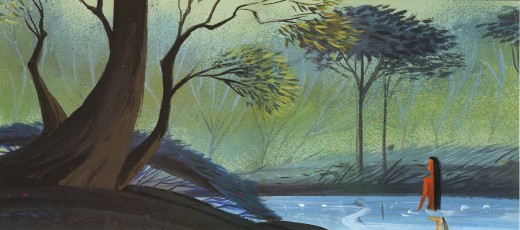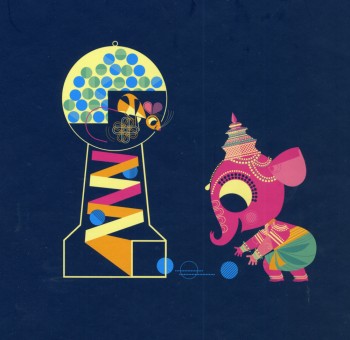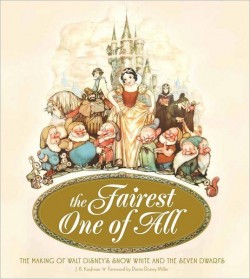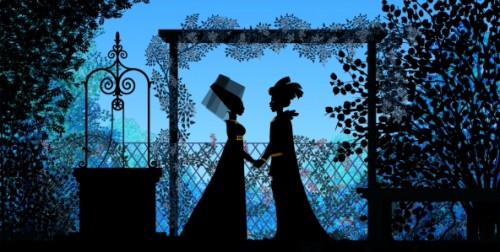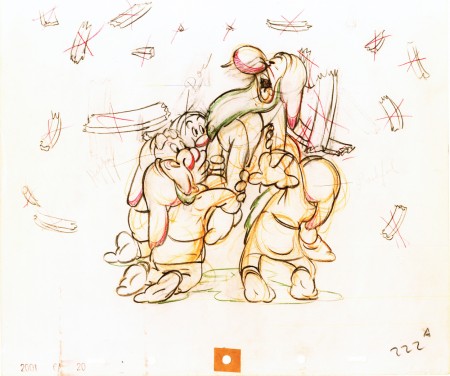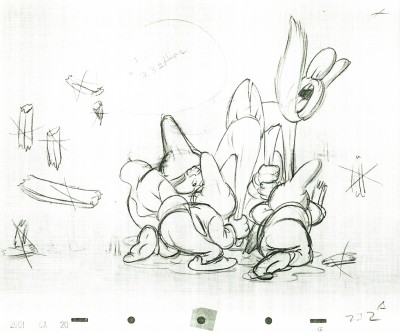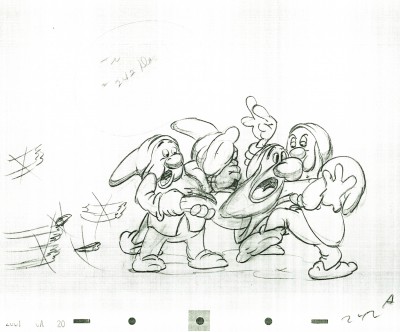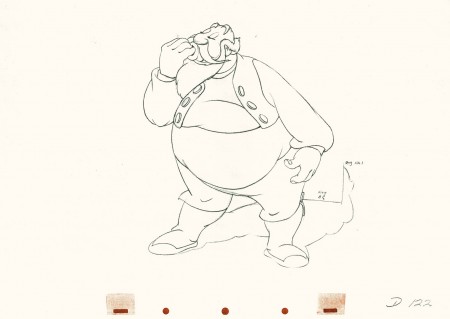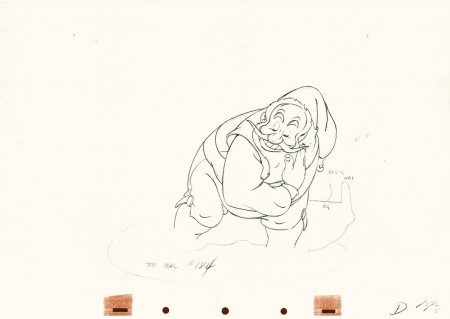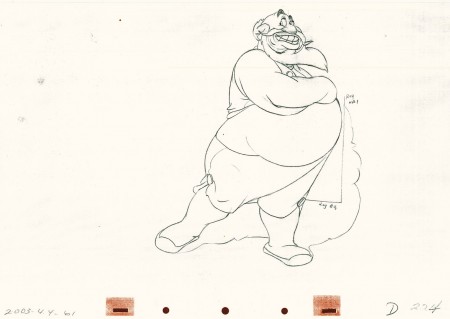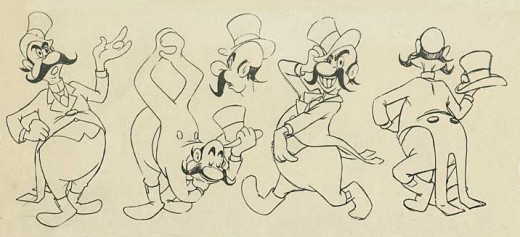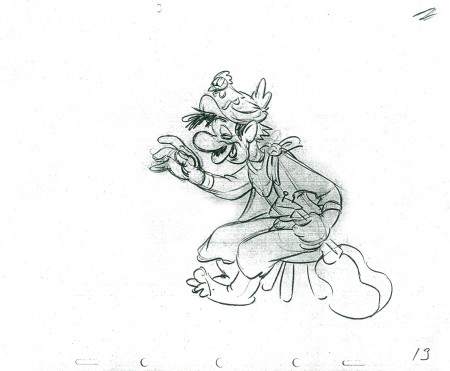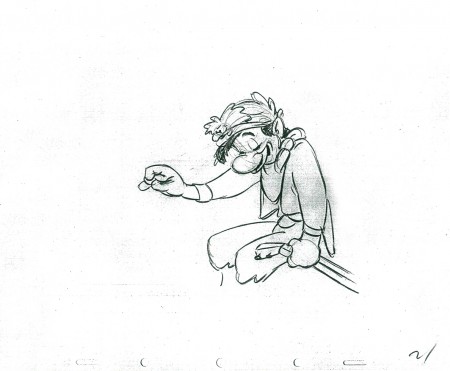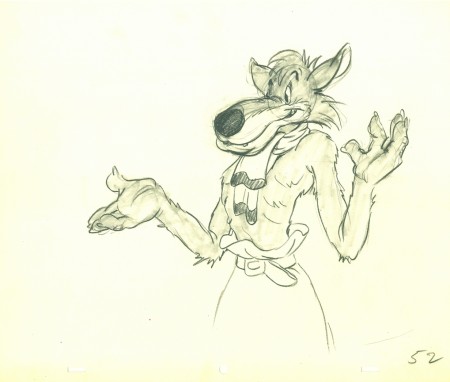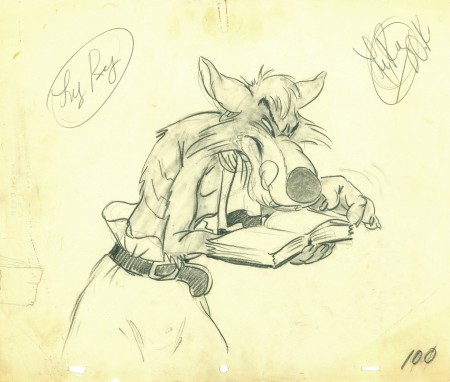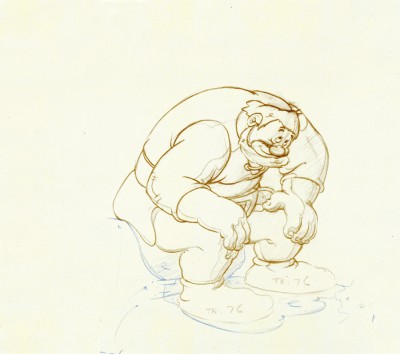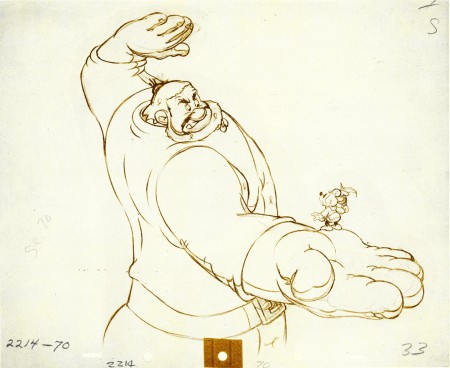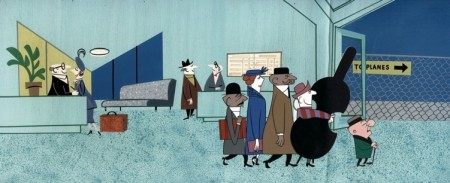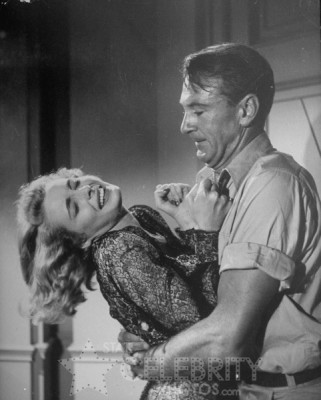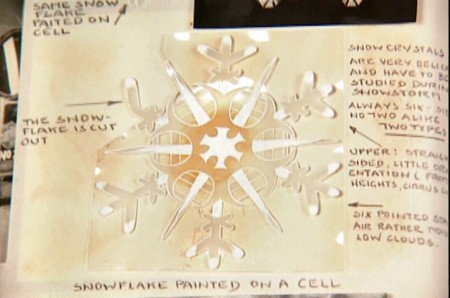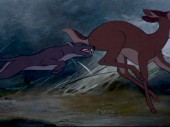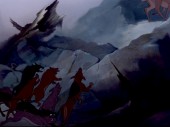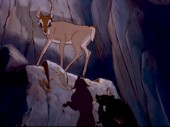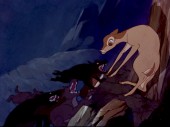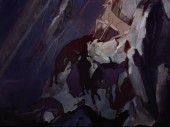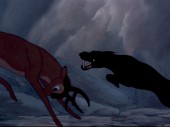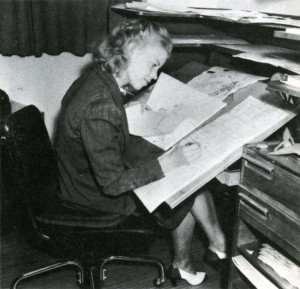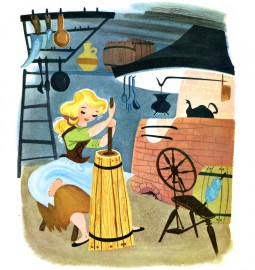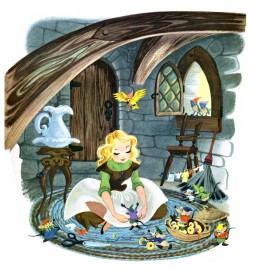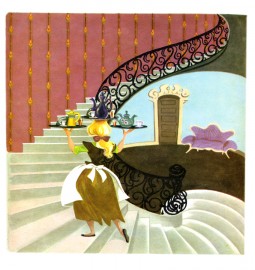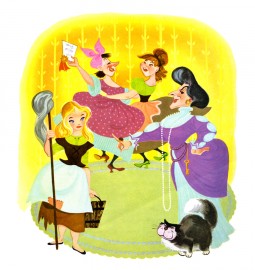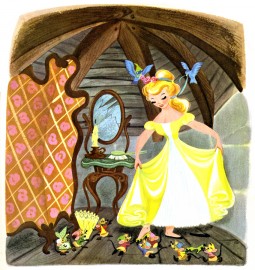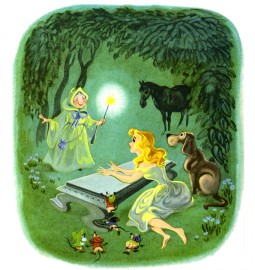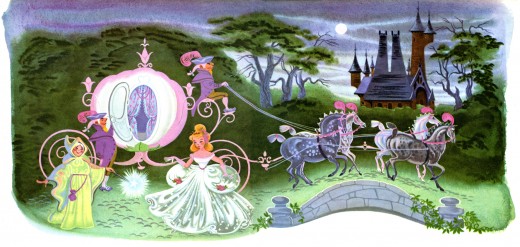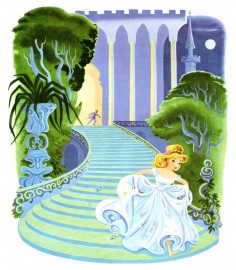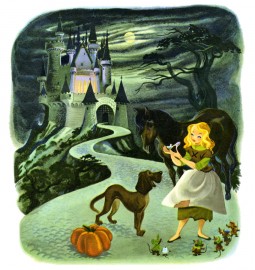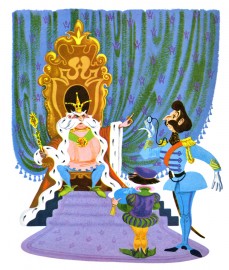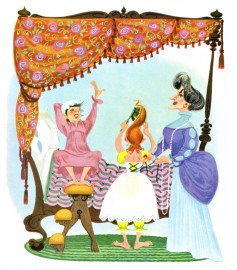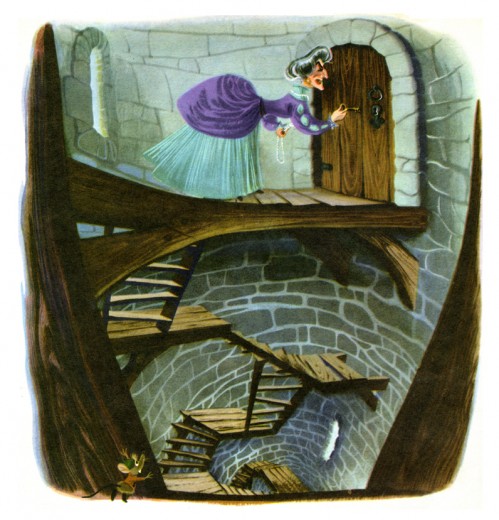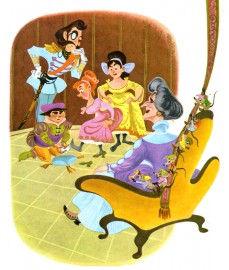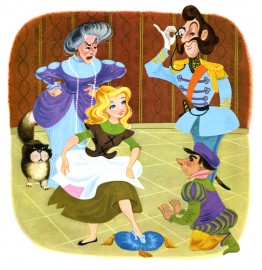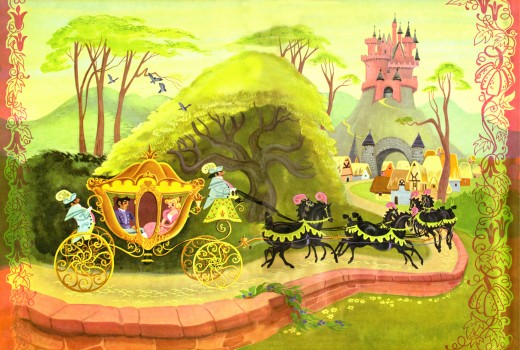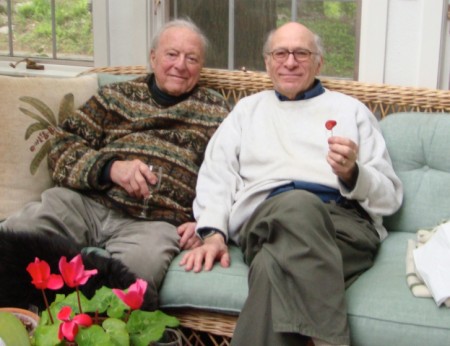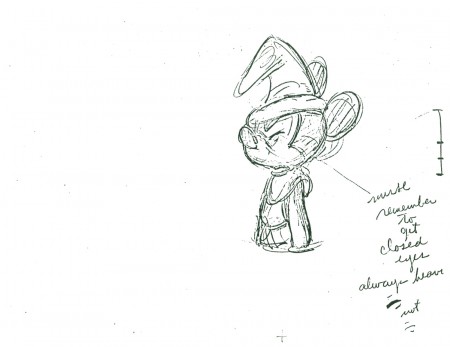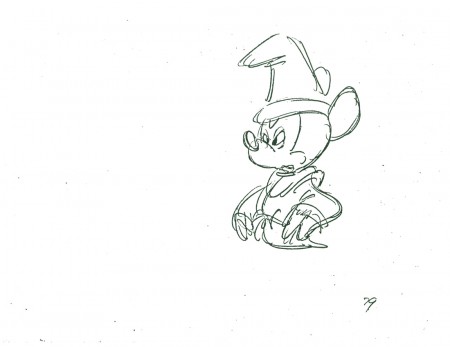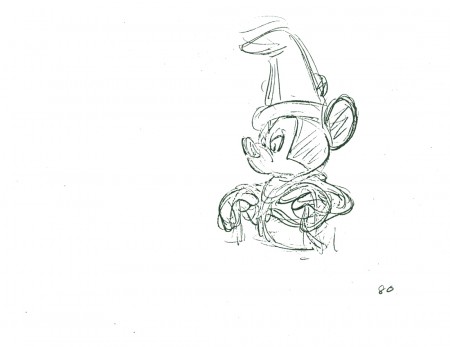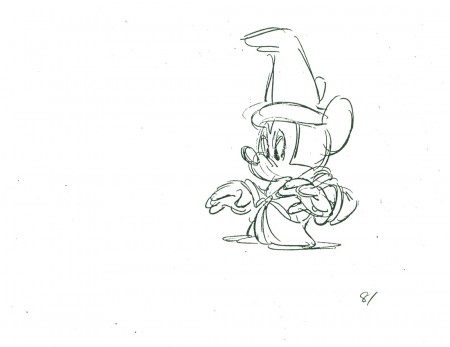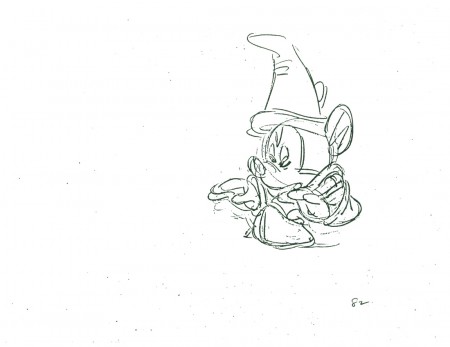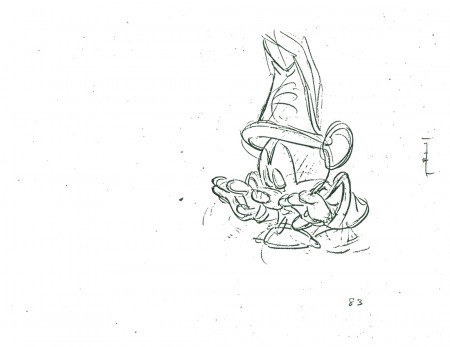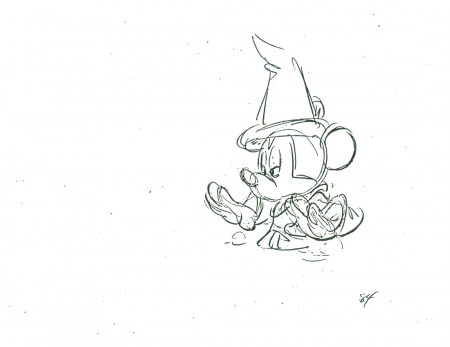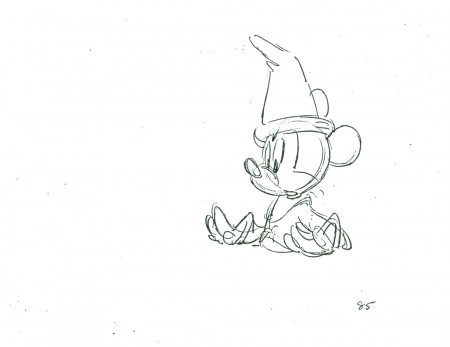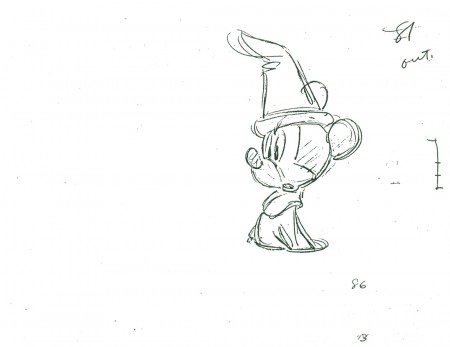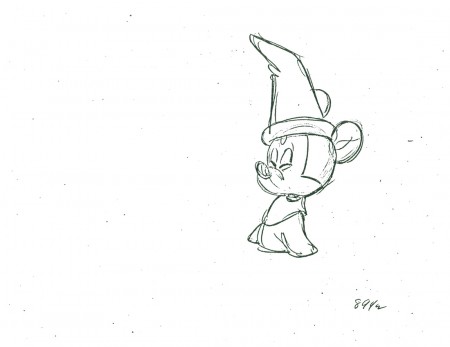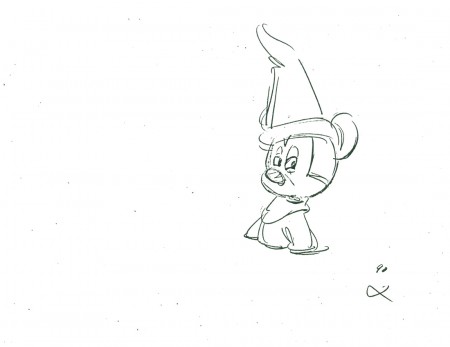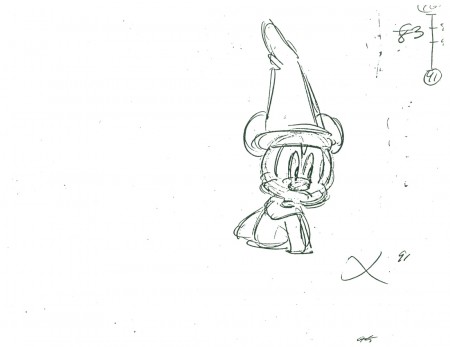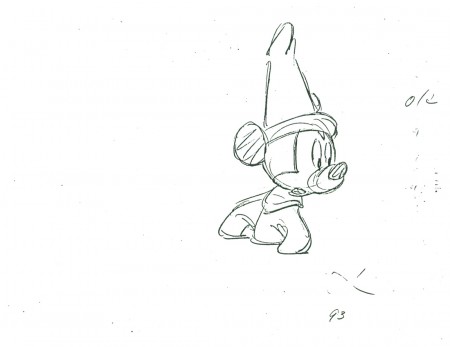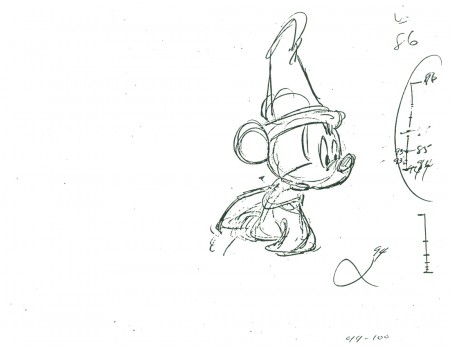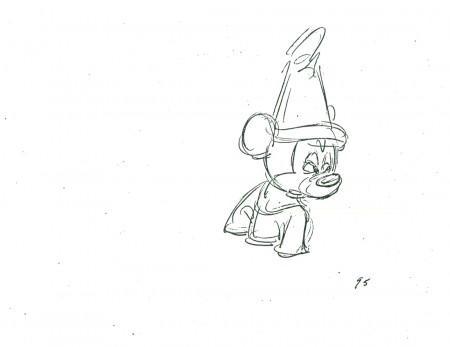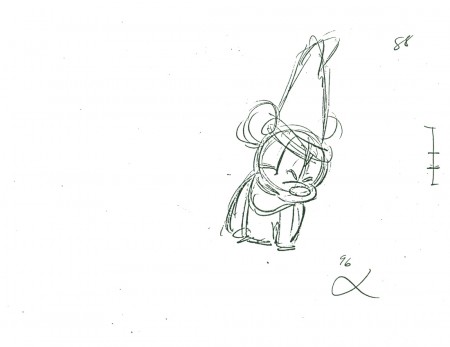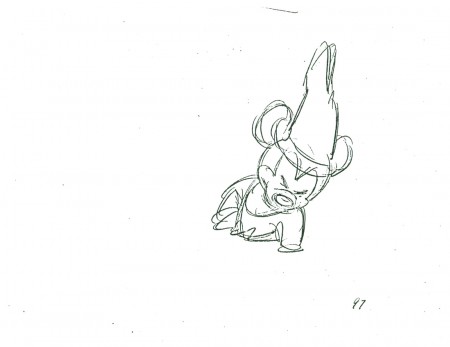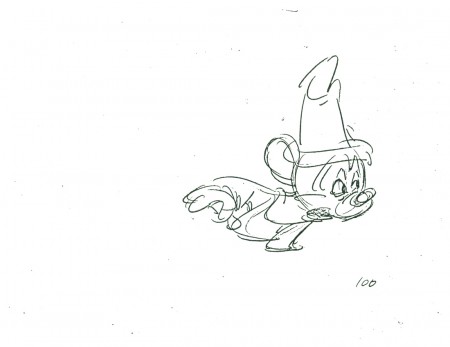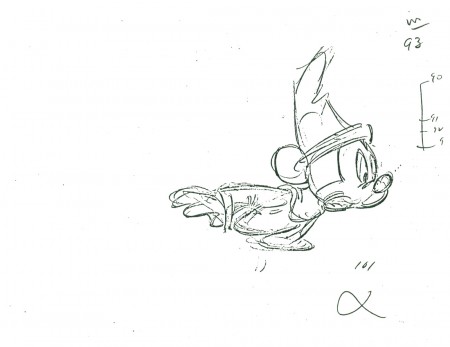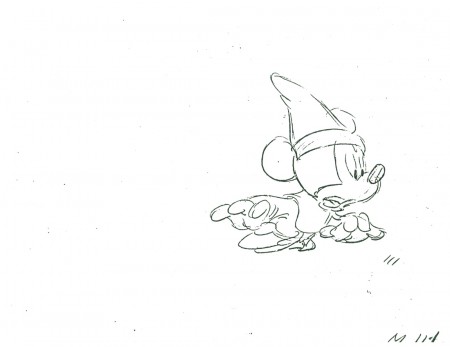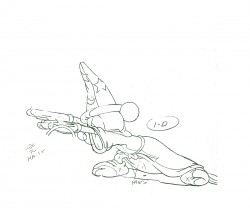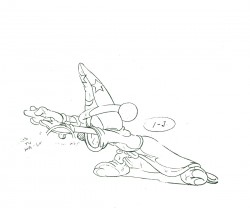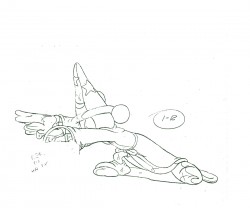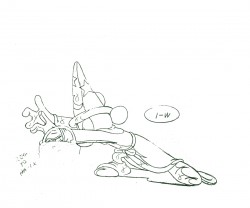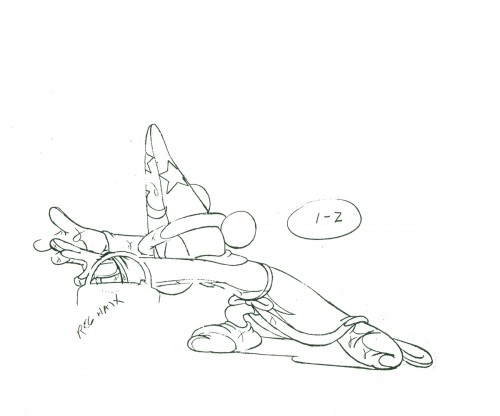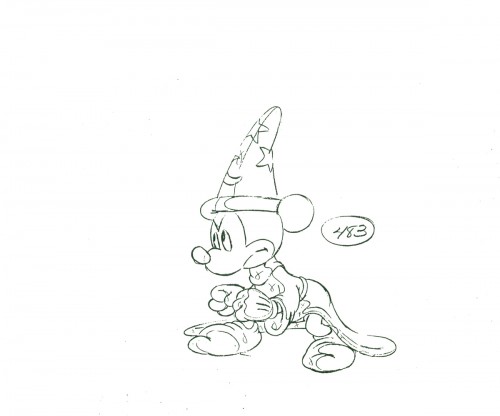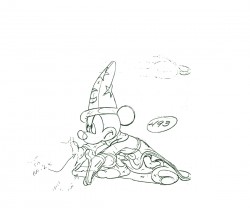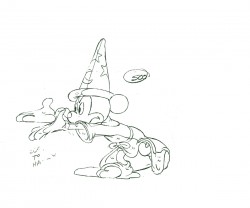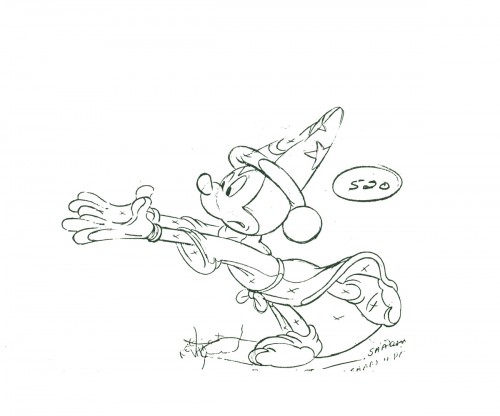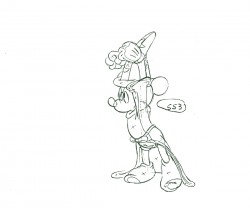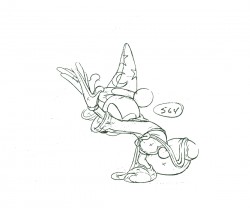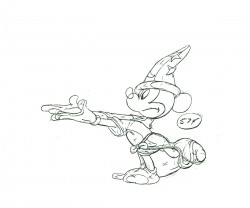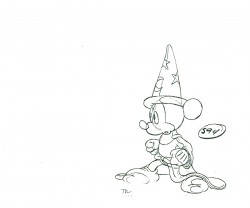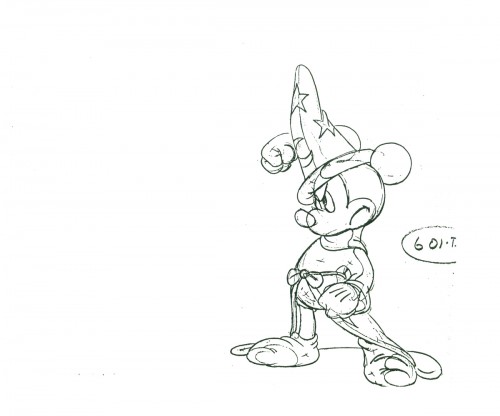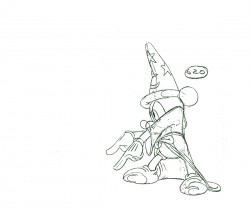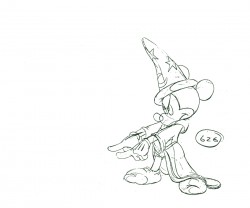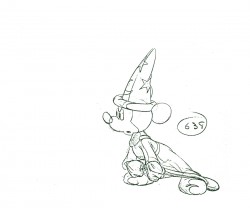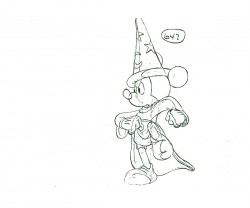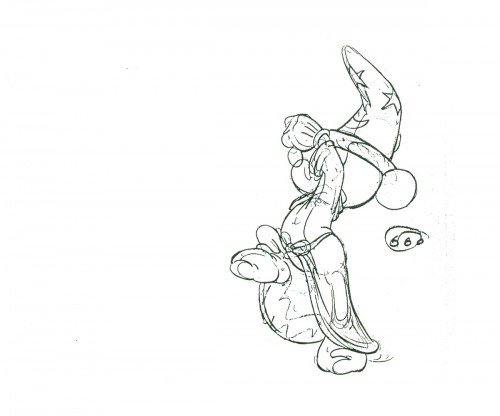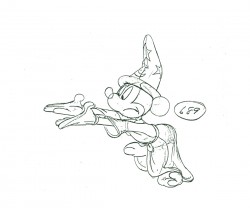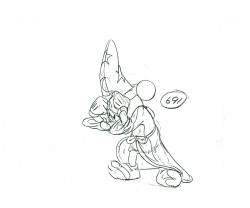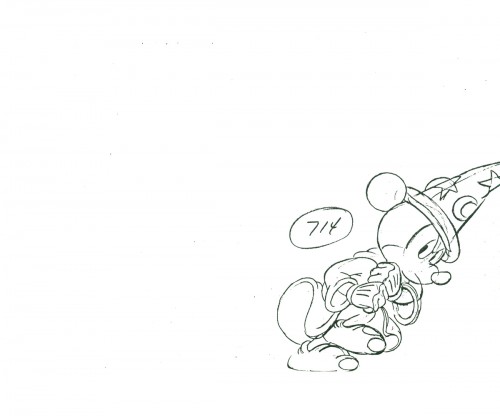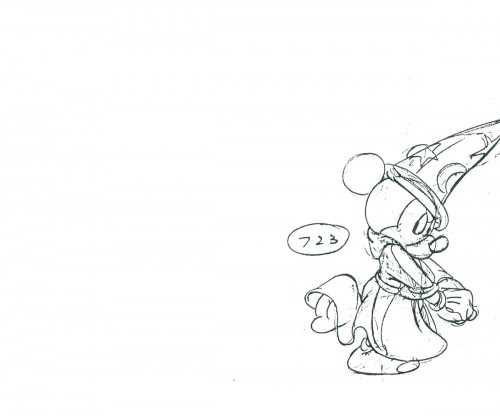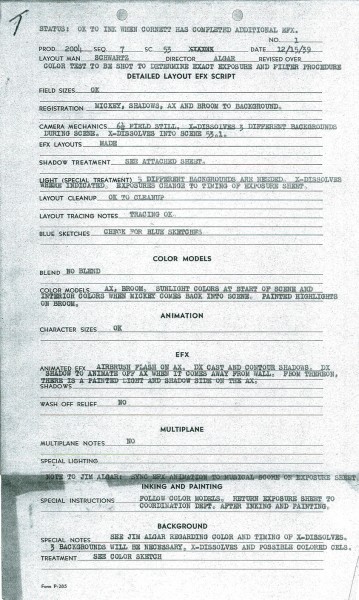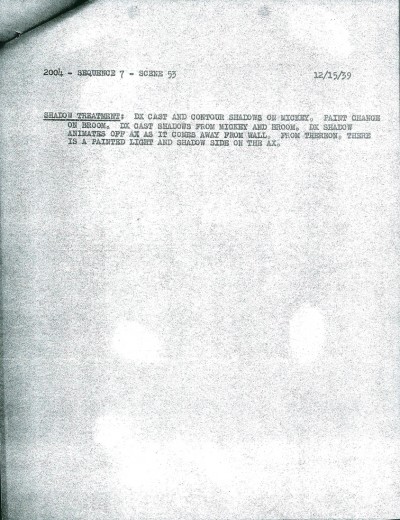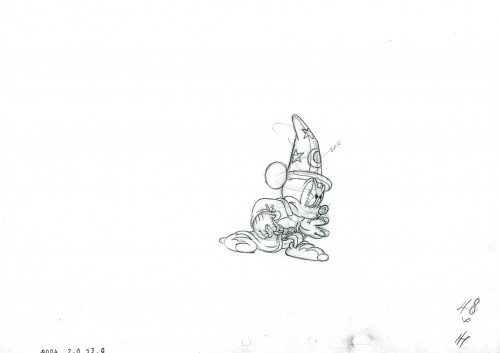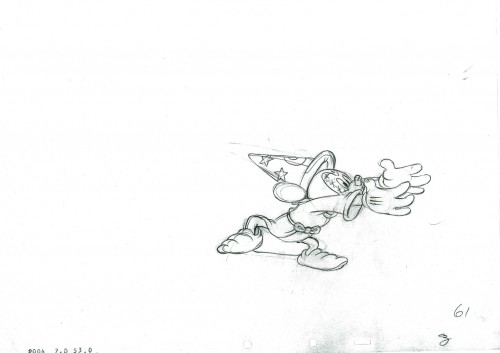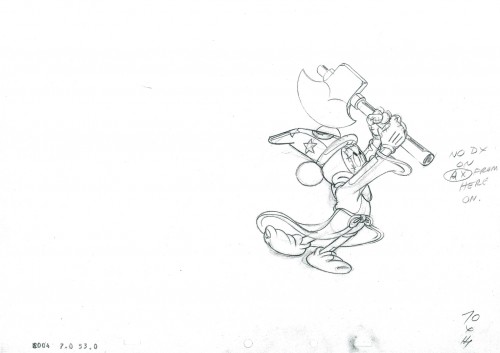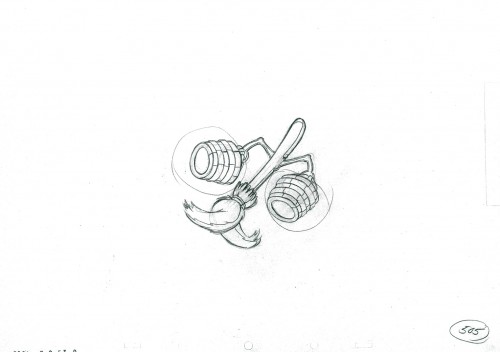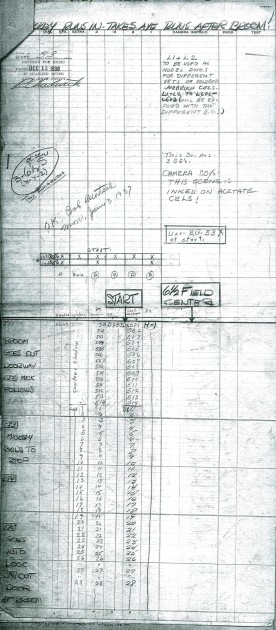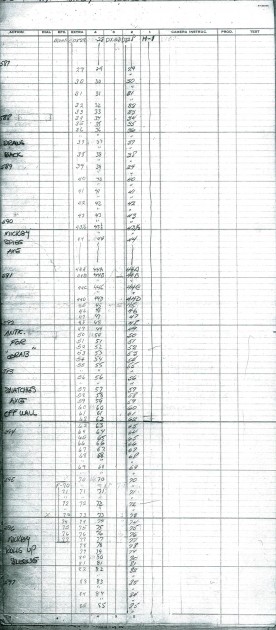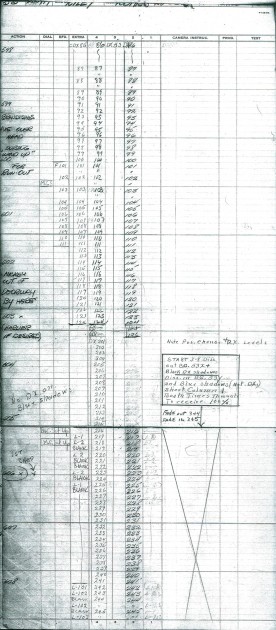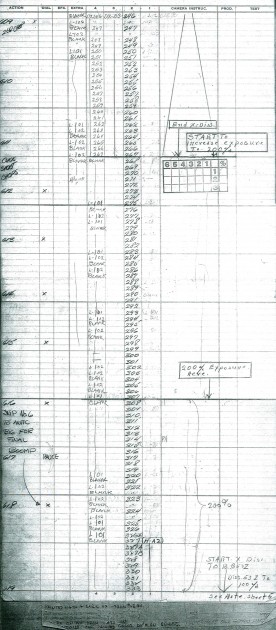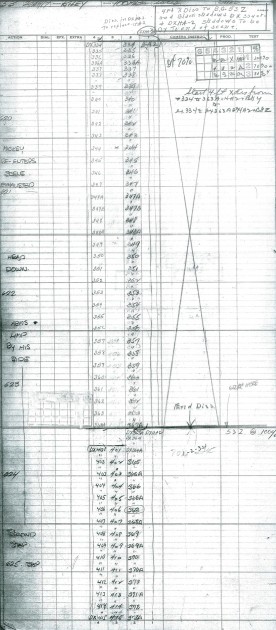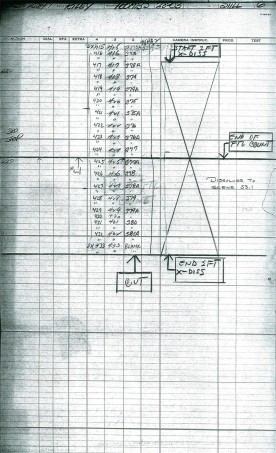Search ResultsFor "fantasia"
Books &Daily post 29 Sep 2012 06:55 am
Egos, Books, and Michel Ocelot
There’s been a relatively short conversation going on at the comment section of my blog for an older piece I’d repeated this past week. The discussion has been about Eyvind Earle. The first few visitors who commented all wanted to express their dislike of this film (particularly the story) and Eyvind Earle’s design work, in particular. “Scott’s” dislike of Mr. Earle’s work extends to his personal attitude while working on the film. He, according to “Scott”, was thick headed and wouldn’t listen to any requested changes to his designs, allowing his ego to take charge of the work. (I’m not sure that I see that on the screen, nor did I really feel that when I met the man when I got to spend an afternoon with him as I accompanied Mike Barrier on an interview. I admit it is possible though.)
In fact, I think the ego is essential in breaking new waves and advancing the art form. Adam Abraham in his book When Magoo Flew writes about the ego of John Hubley in running his productions at UPA. If he wanted a specific blue, that’s all that he would settle for. The report is that he was oppressively insistent on it being his way only. I worked for Hubley for years and never got to see that side of the man. Oh, there was a well deserved and big ego there, but it never got in the way of the art being created.
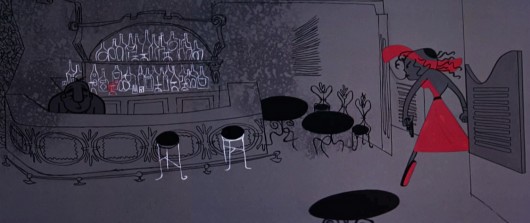
Rooty Toot Toot
We’ve seen Bill Peet complain about Bill Tytla‘s use of his (Peet’s) drawings while working on Dumbo. According to what I’ve read, Peet complains that Tytla took full credit for the sequence of baby Dumbo running in and around his mother’s legs, when Peet felt it was his scene, his key drawings that made the scene the perfect piece that it was.
Chuck Jones, while working briefly for Disney (on Sleeping Beauty), told Walt that he had to leave the studio. When Disney asked what job Jones really wanted at the studio, Jones said, “Yours.” He felt that only Disney’s job was suitable for him. Talk about ego. The ego was even larger than that when you realize that it was Jones, hmself, that told me that story – however real it actuall was. The egos of Jones and Clampett and even Freleng vie over who created what character.
Egos are necessary in an industry of craftspeople and artisans, especially when an artist is trying to get something brilliant out of them. Thomas, Johnston, and even Kahl were brilliant actors with amazing abilities of draftsmanship. But the film, the bigger picture, needed a direction which Earle gave it. Just look at the wretched Reitherman films to see what Thomas, Johnston and Kahl turned out without the strong, smart director who was also an artist. Tytla took animation to another level, he was truly an artist, himself, but look at the miserable little films he directed when he left Disney’s studio. Even the support system of that studio wouldn’t have helped Leprechauns Gold or Snap Happy. (Mind you, I love Snap Happy, but it has no relation to art.)
Here’s a small piece David Parfitt wrote:
- Tytla was a tough guy who used abusive language and irritated his fellow animators. Ken Anderson (Disney Legend for Animation and Imagineering) went to Walt Disney to express frustration at the way Tytla treated his coworkers. Walt Disney replied, “What do you think of Chernabog, the God of evil, in ‘Fantasia’? What do you think of Stromboli in ‘Pinocchio’?†Anderson (the art director for both films) replied, “They are some of the most powerful and vicious villains we’ve ever done.†Walt Disney looked at Anderson and said, “Where do you think all that anger comes from?†Vladimir Tytla was a maverick who needed to release anger and energy to manifest some of the most powerful imagery ever produced by the Disney Studios. A maverick is difficult for a company to grapple with because of their abrasiveness and the way they go against the way things typically run. Yet out of the agitation and irritation often comes a new direction that could secure a company’s future.
Sleeping Beauty changed the Disney studio forever. The animators and artists there, with the exception of Ward Kimball and a few others, fought against the use of 20th century graphics in their films, yet UPA’s influence slowly crept into the mix. Finally when Walt Disney, himself, chose Eyvind Earle and put full support behind him to design this film as he saw fit. The animators all fought Earle and continued to bad mouth him to the end of their days. Yet Earle’s style, as well as Tom Oreb‘s great character designs for that film, are frequently copied by the new generations of artists. The backgrounds and some of the character design are stolen directly from Sleeping Beauty. Even though the SB art is a play on 15th Century manuscripts and art, it was used for the Pocahontas forests.
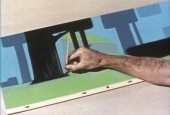
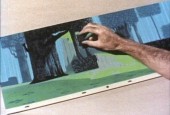
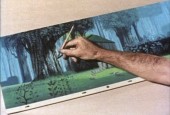
Painting Sleeping Beauty
Nothing at Disney, with the possible exception of Bedknobs and Broomsticks went back to the past to illustrate their films henceforth. Until, of course, today’s new artists in animation who just steal from other past films. Bluth‘s Small One or is virtually without style. Tim Burton is possibly the only exception I can see of this current view of the state of animation. The regurgitated past of other artists who deservedly had egos aglow. We go on. Perhaps someone like Genndy Tartakovsky will bring some of the panasche he brought to Samurai Jack.
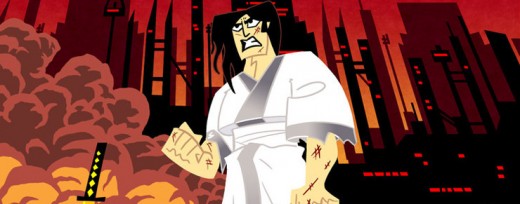
Samurai Jack
By the way, there’s a good interview with Tartakovsky on this week’s on-line version of the Village Voice.
Books
.
- There are a couple of books I’d like to write about.
.
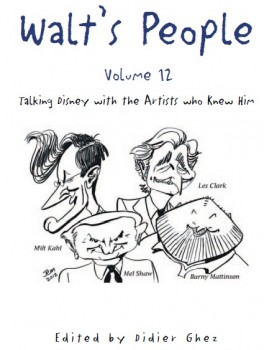
- Let me mention Didier Ghez‘ latest volume of his interview series, Walt’s People.
Just released is Walt’s People – Vol. 12. Just the idea of 12 volumes of any book in print, is quite extraordinary, and amazing feat for Didier Ghez to pull off.
I own about a half dozen of this series and have read all of them at least twice. Most of the interviews are exceptional, some are smart, and the rest are just very good. In all there are those interviews that give us some real insight into the process and history of the making of animated films by the professionals who did it. Les Clark, Larry Clemmons, Charlie Downs, Al Eugster, Sammy Fain, Milt Kahl, Burny Mattinson, Paul Murry, and Mel Shaw are among the many who are interviewed in depth for this new volume. Some of our greatest historians (Robin Allan, Michael Barrier, Albert Becattini, John Canemaker, John Culhane, Pete Docter, Chris Finch, J.B. Kaufman, Jim Korkis, Dave Smith, and Charles Solomon among others) conduct the interviews.
It’s just another great volume in the series. You should own them all; I should own them all, to be honest, and I will.
Ganesha’s Sweet Tooth
- As previously reviewed on this blog, Sanjay Patel will see his first children’s book, Ganesha’s Sweet Tooth released this week by Chronicle Books. I have a sore spot for Mr. Patel’s work. He’s an artist who works by day at Pixar and is an artist, with his own very defined style, working extensively after hours.
I’ve reviewed many of his books and have a real fondness for The Ramayana. Were I you, looking to explore this artist’s work, I’d buy Ganesha’s Sweet Tooth. Once you have it and want more – you will – go for The Ramayana. It’s a brilliant masterwork.
Snow White x 2
- Unless you’ve been hiding under a rock, if you’re an animation fan, you know that the brilliant historian, J.B. Kaufman, has not one but TWO books on Snow White about to appear on the market.
The Fairest One of All: The Making of Walt Disney’s Snow White and the Seven Dwarfs and
Snow White and the Seven Dwarfs: The Art and Creation of Walt Disney’s Classic Animated Film
are the two titles by Kaufman that focus in great depth on that film and its development. This is to celebrate the 75th anniversary of the feature, and will coincide with a display that will appear soon at the Walt Disney Family Museum in San Francisco.
Both books come from the Walt Disney Family Foundation in conjunction with the Walt Disney Family Museum. I’ve seen the Art of Creation book, and was completely taken with it. I will most definitely own both books. The film means much to me, and I want to own anything Kaufman writes. It’s a no-brainer – double my pleasure.
By the way, part of the reason I’m looking forward to reading these two books is to compare it with Michael Barrier‘s amazing writing on this period at Disney’s studio. In Hollywood Cartoons, there’s a large part of the book dedicated to the development andcreation of this particular film. Then in The Animated Man: A Life of Walt Disney Barrier tells the same information but from a different perspective entirely. This biography of Disney is wholly involved with Walt Disney, the man and artist. It’s a unique turn that we only see in the poorly written Diane Disney Miller book, The Story of Walt Disney. As Walt’s young daughter she could see the story no other way than from his perspective. While waiting for the Kaufman books to come out, read either of Barrier’s books for the best, to date, version of the Snow White story. It’s strong writing.
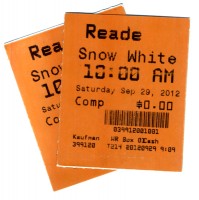 It’s appropriate that I was invited to a 10am screening of Snow White at Lincoln Center this morning. It’s part of the NY Film Festival’s 50th anniversary celebration. Eric Goldberg introduced the film with a brief and smart little talk about the animation. Talking about The Old Mill as a test run for the Multiplane Camera, talking about the Three Little Pigs first offering characters that looked alike but had characterization defined by their animation (as did the dwarfs), talking about The Goddess of Spring being an enormous failure for Ham Luske who succeeded animating Snow White. It was nice to say hello to Eric prior to the film. We haven’t seen each other in about five years. It was nice also to see the film projected. I saw the movie on tv/dvd only a couple of weeks ago, but it’s a very different experience on the big screen. The digital transfer was glorious, merciless and disastrous. The ink lines were so sharp that you could actually feel how deeply the crow quills cut into the cels. However there were many points where individual frames had slight digital distortion to hurt the ink lines, and the magic mirror actually had the detritus of digital compression across the center of the mirror. Someone should have been there to supervise the transfer.
It’s appropriate that I was invited to a 10am screening of Snow White at Lincoln Center this morning. It’s part of the NY Film Festival’s 50th anniversary celebration. Eric Goldberg introduced the film with a brief and smart little talk about the animation. Talking about The Old Mill as a test run for the Multiplane Camera, talking about the Three Little Pigs first offering characters that looked alike but had characterization defined by their animation (as did the dwarfs), talking about The Goddess of Spring being an enormous failure for Ham Luske who succeeded animating Snow White. It was nice to say hello to Eric prior to the film. We haven’t seen each other in about five years. It was nice also to see the film projected. I saw the movie on tv/dvd only a couple of weeks ago, but it’s a very different experience on the big screen. The digital transfer was glorious, merciless and disastrous. The ink lines were so sharp that you could actually feel how deeply the crow quills cut into the cels. However there were many points where individual frames had slight digital distortion to hurt the ink lines, and the magic mirror actually had the detritus of digital compression across the center of the mirror. Someone should have been there to supervise the transfer.
Paperman played prior to Snow White. It was animated cgi, then flattened and lines were added atop the flattened drawings. I can’t for the life of me understand why it wasn’t just animated by hand. It would have cut the cost in half and had more life to it. Sorry, I don’t think it worth the Oscar. Though you never know it may be the best film, this year.
Tales of the Night
- Michel Ocelot has received another excellent review from the NYTimes. Tales of the Nightis reviewed by Andy Webster in the Times, and is Ocelot’s latest feature length animated film – his first in 3D – and the reviews are sensational. It’s screening as part of the Children’s International Film Festival and plays at New York’s IFC Theater through next Tuesday. This is a silhouette film in brilliant color.
His films are beautiful and deserve to be seen in a theater. I’d heartily recommend getting to the theater if you have the chance. Hopefully the distributor will submit this one for Oscar consideration. Though the look is 2D, the graphics are done via cgi as was the case with his past films, including Azur & Asmar, Kirikou et les betes sauvages, Princes and Princesses, and Kirikou and the Sorceress.
Some amazing animation is coming out of France these days.
More Reviews
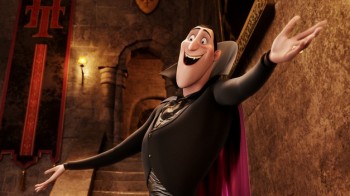 Now to the bigger release for the smaller film department:
Now to the bigger release for the smaller film department:
Adam Sandler‘s second animated feature, Hotel Transylvania, opened to mostly poor reviews by 2nd string reviewers.
NYTimes sent Neil Genzlinger to give his negative review. The most positive line is: “The movie loses its originality as it rolls toward its predictable conclusion, but it’s still lovely to look at.”
Someone named Sara Stewart reviews the film for the NYPost and gives it a middling 2½ stars. “Director Genndy Tartakovsky (“The Powerpuff Girls,†“Samurai Jackâ€) is a natural fit for this kid-and-parent-friendly flick. The animator’s wit and attention to detail enliven a collection of well-known ghosts and ghouls. (Though Tartakovsky’s more traditional TV-cartoon style is still superior, as evidenced by his playful closing credits.)”
Joe Neumaier, the 2nd rate first stringer of the NYDaily news gave it a mostly positive 3 star review. “This being a Sandler movie, the humor skews toward the infantile (fart jokes, peeing baby werewolves). But the sleek visuals are rich and glossy, placing the characters, who look like Halloween door decorations, in baroque hallways or secret passageways.”
I enjoy the reviews in The Onion, and their review for this film by Tasha Robinson doesn’t disappoint. A C+: “Tartakovsky gets a long way on wild design and visually daring sequences. His work has always been adventurous, experimental, and conceptually creative, and he hasn’t lost any of his energy or capacity for staging a memorable setpiece.”
Whatever happened to the feature length version of Samurai Jack that J.J. Abrams was going to produce wth Tartakovsky directing?
Action Analysis &Animation &Animation Artifacts &Disney &Tytla 13 Sep 2012 05:48 am
Tytla’s Terry-Disney Style
- Bill Tytla is probably the finest animator who has graced the history of the medium. He was a brilliant actor who dominates most of the classic early films of Disney work. Snow White, Pinocchio, Dumbo, and Fantasia are all appreciably greater films because of his work. In studying this master’s work frame by frame you can see a real elasticity to the character, one that is not apparent in the motion of those same characters. There’s true emotion in the acting of these characters, and it’s apparent that he uses that elasticity to get the performances he seeks.
There’s something else there: Tytla’s roots were in Terrytoons: I have no doubt you can take the guy out of Terrytoons, but it seems you can’t take the Terrytoons out of the guy.
Let’s look at some of the drawings from some of the scenes I posted here in the past.
Where better to start than with those gorgeous dwarfs from Snow White. Here’s a scene I posted where all seven are animated on the same level as they carry Grumpy to the wash basin. If he won’t clean himself, then the other six will do the job for him. Take a look at some of the distorted characters in this scene, then run the QT movie. Look for the distortion in the motion.
As for the drawing, like all other Tytla’s scenes it’s beautiful. But tell me you can’t find the Terrytoons hidden behind that beautiful Connie Rasinski-like line.
Flipping over to Stromboli, from Pinocchio, we find animation almost as broad as many Terrytoons, the difference is that Tytla’s drawing that roundness and those enormous gestures on purpose. He knows what he’s doing and is looking to capture the broad immigrant gestures of those Southern European countries. Stromboli goes in and out of distorted drawings, as I made clear in a past post.
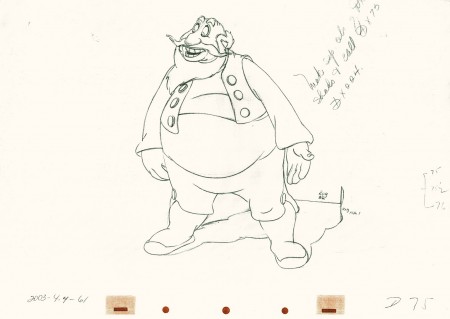 75
75
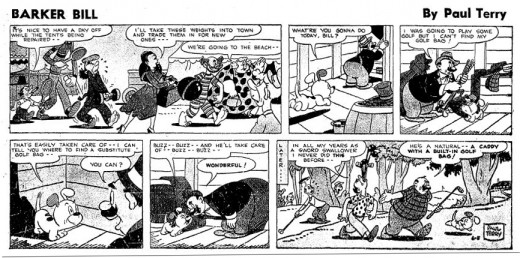
A strip by “Paul Terry”as starring his 1930s character, Barker Bill.
Borrowed from Mark Kausler’s blog It’s the Cat.
The Laughing Gauchito was a short that was, no doubt, going to be part of The Three Caballeros. Tytla, Frank Thomas and Ollie Johnston had all animated for the short before Disney, himself, cancelled the production.
Here are three drawings from the film, and they are all beautiful extremes from the scene. (Tytla marked his extremes with an “A” to the right of the number, or at other times with an “X” in the upper right.) The beautiful roundness does not come at the expense of his drawings. Below the Laughing Gauchito we see a cartoon drawing by Carlo Vinci from a 1930′s Terrytoons short.
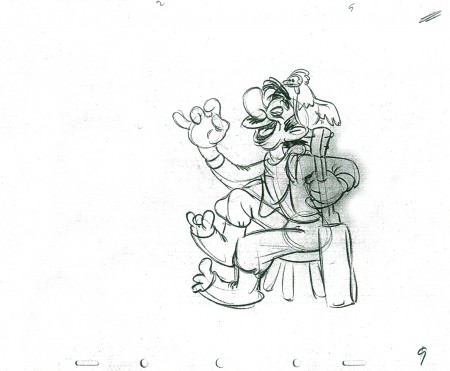 9
9
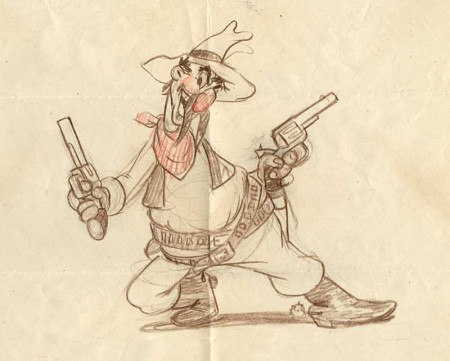
A Terrytoons drawing by Terry artist Carlo Vinci from a mid ’30s short.
borrowed from Animation Resources
Here’s a scene Bill Tytla did for a Harman-Ising cartoon. He was the supervising animator, and the lack of Disney becomes evident in the drawings. The animation is closer to a Terry short than what he did at Disney’s. The movement feels muddy in that actual cartoon. I’m sure it was his own animation trying to blend with the style of Harman’s work.
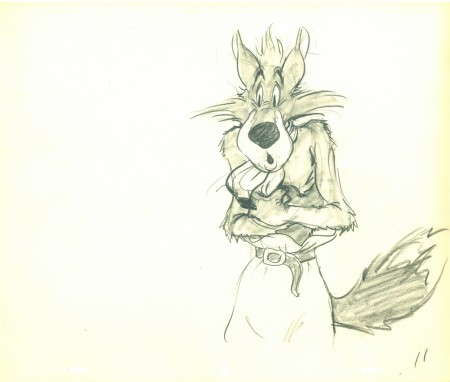 11
11
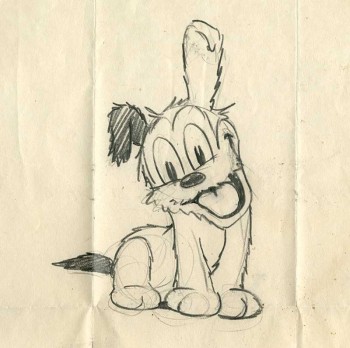
Another beautiful Carlo Vinci drawing from a 30′s Terry short.
borrowed from Animation Resources
And here’s a drawing out of a Little Lulu cartoon. I’s not a film directed by Tytla, and is not a good drawing. But Tytla’s influence on all the Lulu shorts at Paramount at the time can’t be denied. It certainly looks more Terrytoon than Paramount. This is not even a good Terry drawing – though its for a Paramount cartoon.
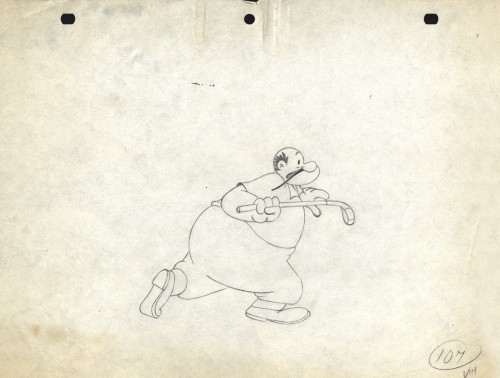
Back at Disney, Tytla animated Willie the Giant from the Mickey short, The Brave Little Tailor. This character, like Stromboli, owes a lot to Terrytoons. I felt this when I first saw the short as a child, and I still think it true. The same, I think, is also true of the same Giant character when he appears in Mickey and the Beanstalk, which Tytla obviously didn’t animate but would have handled if he’d stayed at the studio.
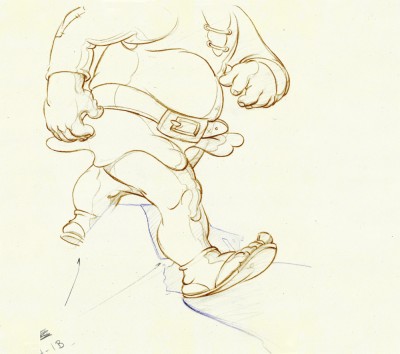 3
3
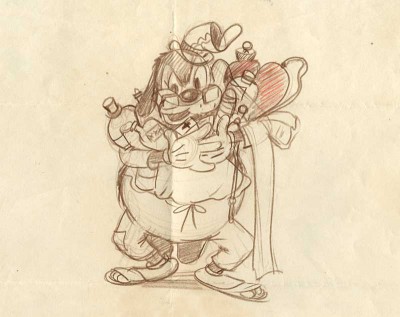
Another Carlo Vinci sketch.
borrowed from Animation Resources
This following, last drawing is a Tytla drawing I own. I know Tytla did it. He gave it to Grim Natwick who gave it to Tissa David who gave it to me. It’s a gem.
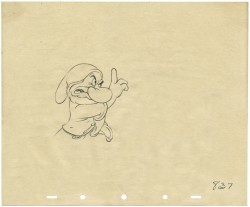
Commentary 25 Aug 2012 05:56 am
Commentary Times
Tissa David‘s nephew, Mate Hidvegi, sent me a number of excellent photos of Tissa, which were shot in this past year. I’d like to share a couple of the pictures Mr. Hidvegi has shared with me.
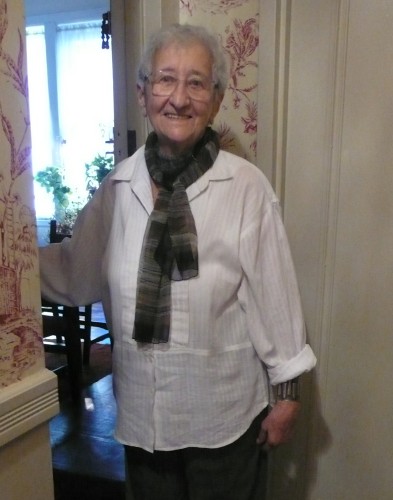
Tissa, greeting visitors as they get off the elevator. May 2012
This is exactly how I remember and will remember her.
A perfect photo.
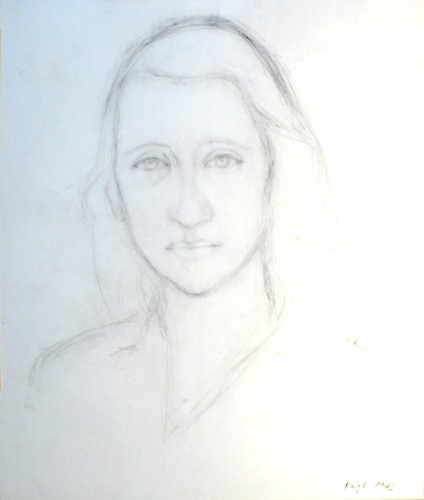
Tissa’s good friend, artist Judith Reigl, drew this portrait
of Tissa in 1942. (Owned by Tissa’s sister, Katalin David.)
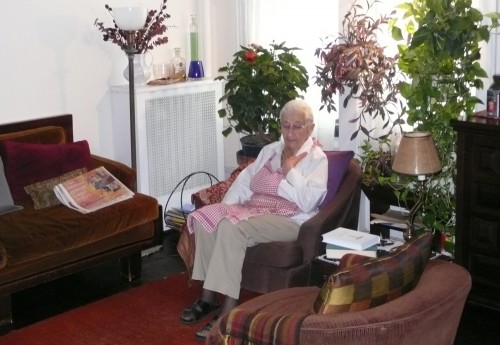
Tissa, sitting in her living room, May 2012
This is an amazingly beautiful photo.
Enlarge it for the full picture which is exact and accurate in its colors.
Years ago, I remember sitting through Fantasia at a private screening in John Canemaker‘s apartment. This was before the days of home video or dvd. John had secured a beautiful 16mm print for the occasion. This film was seminal to John’s life and spirit; I knew that and I suspect that Tissa also knew it. I’d also seen the film about 20 times in the year prior to that screening; it had just been re-released in NY for the first time in many years. I felt that the film had some of the greatest work of the Disney artists, and I also felt that it had some enormous lows.
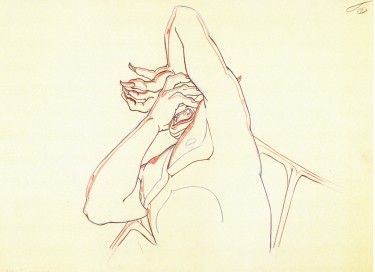 At the end of the film, Tissa immediately piped up and proclaimed it a horrible movie. (John used to impersonate Tissa’s comment for years after, and it always brought a laugh.) She was overstating her thoughts, obviously, but for comedic effect. She hated the Pastoral and other kitschy parts of the film, but she undoubtedly loved the brilliance of Bill Tytla‘s devil or the strength of Reitherman‘s dinosaurs. Even the excellence of Kimball’s Bacchus couldn’t be denied. However, the overall effect was questionable, especially in that apartment screening where it wasn’t the overblown big screen and stereophonic sound version, and its flaws were more obvious.
At the end of the film, Tissa immediately piped up and proclaimed it a horrible movie. (John used to impersonate Tissa’s comment for years after, and it always brought a laugh.) She was overstating her thoughts, obviously, but for comedic effect. She hated the Pastoral and other kitschy parts of the film, but she undoubtedly loved the brilliance of Bill Tytla‘s devil or the strength of Reitherman‘s dinosaurs. Even the excellence of Kimball’s Bacchus couldn’t be denied. However, the overall effect was questionable, especially in that apartment screening where it wasn’t the overblown big screen and stereophonic sound version, and its flaws were more obvious.
Tissa blew the same trumpet on many other Disney features. There was a Museum of Modern Art screening of Jungle Book with Eric Larson, Ken Anderson and Gilda Ratner present to talk. I had all I could do to stay awake during the film. (Those horrible voices – Phil Harris, please!) Finally, it ended, and Tissa whispered the opinion, “What a dreadful movie!” I could only laugh. I thought I was the only one with that opinion, and she was voicing my thoughts (and covering up the fact that I slept through it.) We laughed together.
She absolutely loved Frank Thomas’ squirrel sequence from Sword in the Stone.As a matter pf fact, she had a soft spot for a number of Thomas’ sequences.She also loved Marc Davis’ work. His Cruella de Ville certainly stood out. Tissa surprised me during Beauty and the Beast when she praised a half shot of Belle walking and said it was a good walk. (This was within the castle while a prisoner of the beast.) You couldn’t see Belle’s feet, but Tissa believed it. This was high praise from her. By then I’d been concentrating more on the direction than the animation, so I was glad she caught me not paying attention to the screen action. She woke me up again, in a different way this time.
There were many gems Tissa praised to the hilt. The first time we saw Caroline Leaf‘s film, The Street she was full of superlatives. Tissa was a judge in Ottawa when Norshtein‘s Tale of Tales won Best in Show, and it deserved it. We sat through that film many times together. We both loved it. The Quay Brothers confused much of the audience that year with their early film, Nocturna Artificialia, but she loved it. Sodid I, and we spent a lunch talking about it.
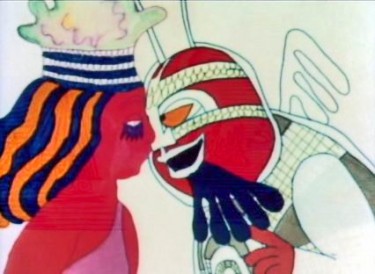 In 1974, she opted not to work on the Hubley film, Voyage to Next (she never told me the reason though I believe it was because John was lowering her salary considerably – he had so little money on this film – and she had to stand up for herself), but she praised, privately to me, the animation of Bill Littlejohn even though she wasn’t crazy about the final film.
In 1974, she opted not to work on the Hubley film, Voyage to Next (she never told me the reason though I believe it was because John was lowering her salary considerably – he had so little money on this film – and she had to stand up for herself), but she praised, privately to me, the animation of Bill Littlejohn even though she wasn’t crazy about the final film.
She shared a long list of things she didn’t like in her own work on films like Eggs, and Raggedy Ann. She also loved working on both films, and loved working for both directors – John Hubley and Dick Williams. After working on animation for Candide for Bob Blechman – low salary long hours and difficult but beautiful work – she told me privately that she would not work on any more films for Bob. She hated how the studio had reworked her animation and changed the cutting. She felt all her hard work had been damaged.
In short, I learned from Tissa that I should trust my judgement. I also used judicious thought in airing my opinion; I was always concerned about hurting the feelings of others. Tissa showed me that I had a strong and contrary opinion, but really I was just looking for my idea of quality. It was easy to say how much I liked things I didn’t, but it was hard to speak the truth and tried to articulate why. It isn’t always easy, but it’s certainly necessary for me. I suppose that makes me not always liked within the community, but the art of animation is too important for me. If my honest opinion gets someone to do better, it’s worth it.
Not too long ago an award winner at an animation festival offended me. At the after party, I told the film maker that his half of a walk cycle was an unforgivable cheat. The budget was the excuse that didn’t sit with me, and I stupidly hurt the animator/director. He hasn’t done half a walk cycle again, and I think my rudeness paid off. Especially in that he’s a gifted artist, and his work was better than what he offered us – even winning an award.
Tissa’s unforgiving critiques of my work, and there were many of them – many – over the years was always helpful. Every single comment from her, whether about my work or other people’s work, taught me something. The positives meant so much more because the negatives were just as honest. I’ll miss her barbs and her lessons. However, I have to say my own opinion of my work is more critical than she ever could have been. I just don’t have a second voice to back me up anymore, and I seriously miss that.
UPA Production Numbers
- Following in the lead of Thad Komorowski‘s listing of production numbers from M-G-M and Warner Bros cartoons, Adam Abraham has opted to add all Production Numbers, he has for the UPA films. This list is complete to about 1956 and includes all the Columbia shorts.
This site, When Magoo Flew, is not only a good companion to the book but is excellent and informative in its own rite. There’s plenty of information here that doesn’t even appear in the book.
Paul Rand . . . I mean Ayn Ryan
- For all those psychotic Paul Ryan lovers, Ayn Rand‘s The Fountainhead will be broadcast on TCM on Sunday, August 26 at 02:30 AM.
This gave me one of my favorite moments as an Academy member. It was a memorial service for Gary Cooper, who had died way back in 1961. They had clips from a number of his great films and a number of speakers who were part of his life (or he was part of their lives.) It was moving smoothly when Patricia Neal came to the microphone, dressed in a bright, slinky, crimson dress. She gave a short-ish speec which started with,”
“Gary Cooper was the love of my life.”
She revealed something that was obvious to many at the time. She and Cooper, while filming The Fountainhead, fell in love. Cooper was married and loved his wife. He would not leave his wife and child for Patricia Neal on her first film. The affair turned to an end. Neal was brokenhearted and told us, many years after. She told us she still loved Gary Cooper. It was a very emotional speech.
They followed with a clip from The Fountainhead.
Maria Cooper, Gary Cooper’s daughter, followed the clip and didn’t talk about Patricia Neal.
Olympiad Twenty
I’ve received a notice about the following animated short pieces geared to the Olympics. (Better late than never.) They’re very short animated clips that lead one into another. The note that came with the email read as follows:
- We’ve just made a series of 7 x 20 second animations in just two weeks with
one animator, which is getting really good feedback.
Wondered if you might like to see our animation and share it if you like?
Any feedback you can offer is most appreciated.
Kath Shackleton, Producer
Fettle Animation
Personally, I’m not the biggest fan of the material, however, I thought many of you would like them. The punchlines are consistently nasty and unpleasant, making the stories not very interesting to me. The animation seems excellent for Flash type work. A lot of labor went into them; I wish the writing had been more creative rather than nasty.
Please feel free to leave your comments for them; I’m sure many of you will like them more than I. It’s just my sentiment – my taste – in this period of world history.
Animation &Animation Artifacts &Disney &Hubley &John Canemaker &repeated posts 20 Aug 2012 05:53 am
Fantasia FX – Schultheis – recap
John Canemaker recently completed his latest book about Herman Schultheis and the effects department at Disney’s during the early 40s. It, hopefully, will be published in late 2014. This encouraged me to pull up this piece I posted in Sept/2009. It’s amazing how much information I was able to cull from the photos I found on the DVD.
I’m pleased with this post and am glad to repeat it for those who might not have seen it. John’s book, by the way, is one I’m looking forward to reading. He’s written a bit about it on his website.
- Herman Schultheis was an effects animator who worked on Fantasia. He kept a tight record of the effects they were creating from 1938-1941 and a photo display of how they were done. Schultheis disappeared in 1954 while trekking through Central America, and the notebook was forgotten until his wife’s death in the early 1990s, after which it was discovered by Howard Lowery behind the couple’s bedroom wall.
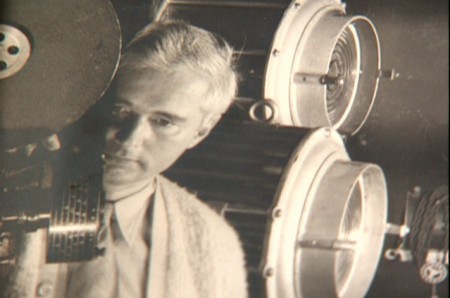
(Click any image to enlarge.)
Herman Schultheis created the book of charts and photos
which gives us a link to the many creative effects in the film.
The book is on display at the The Walt Disney Family Museum. It’s also been digitized so that visitors are able to go through the book, enlarge photos and view it page by page. An interactive display.
Prior to the discovery of the book we were able to figure out a few of the effects. One Disneyland show, in fact, recreated the bubbling lava scene from the Rite of Spring sequence.
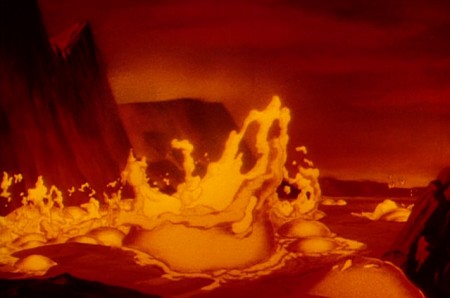
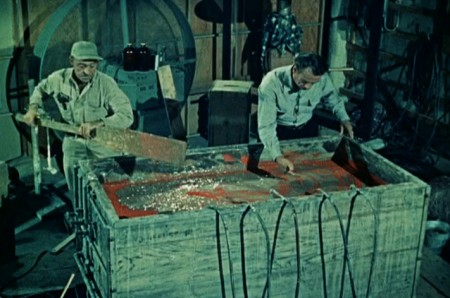
Josh Meador recreated the slow motion shoot of the
boiling concoction used to develop the bubbling lava.
However, the book revealed so much more than we’d understood
about how the superb effects had been crafted.
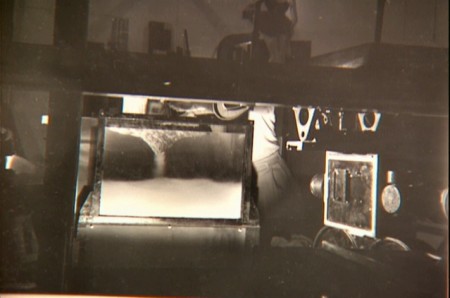
Using a vat of water, they were able to
drop ink into the liquid and film it in slow motion.
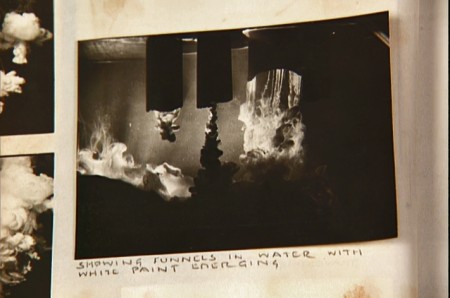
A photo of the ink spilling into the water behind built-in mattes.
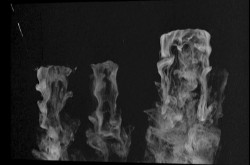
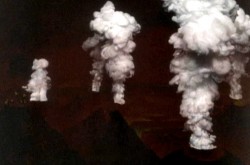
Taking the shot of the ink, they then turned it upside-down.
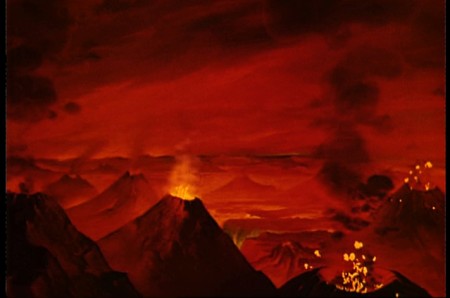
They then superimpose the “smoke” (or ink) over the volcanoes.
This same effect was used in Close Encounters of the Third Kind
to create clouds when the alien ships were moving in on the
farmhouse where the boy and mother lived.
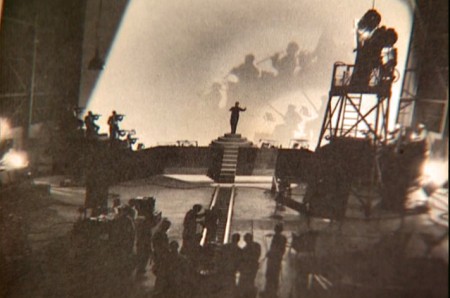
The orchestra was shot on a set with strong, planned shadows.
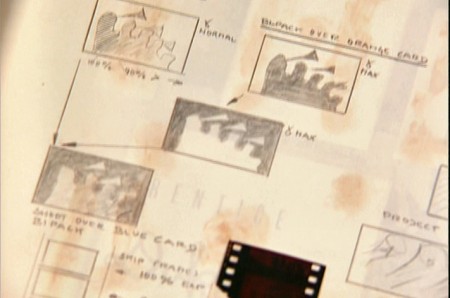
All these shots were orchestrated and planned for color effects.
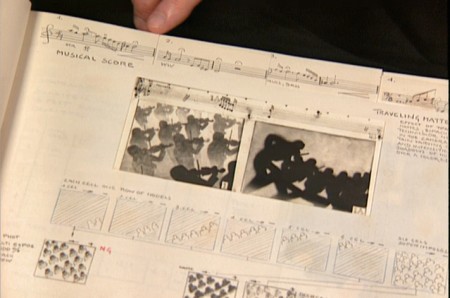
They were also catalogued by Schultheis who kept close
track of the music, as well, in his book. You can see a
page by page breakdown of the score at the top of the page.
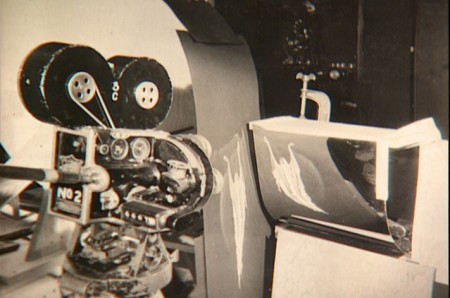
You can see the highly polished sheet of metal (middle left) which reflected
and distorted the animation drawings. This is what the camera photographed
in some of the scenes during the Night on Bald Mountain sequence.
It was also used for the fire in Bambi.
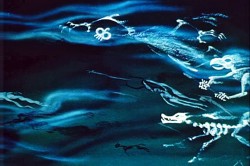 1
1 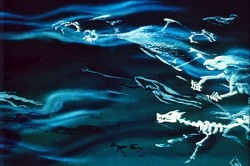 2
2
This scene’s ghosts were shot using that distorted metal reflection.
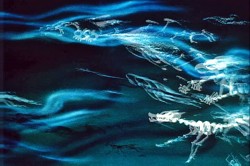 2a
2a 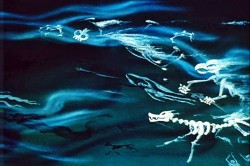 3
3
The ghosts also used a form of cross dissolve.
John Hubley explained to me how that was done, and
we used the technique in Everybody Rides the Carousel.
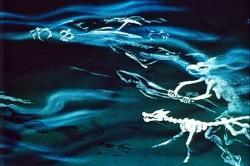 4
4 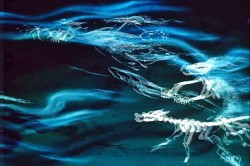 4a
4a
They shot the entire scene at 50% exposure. Then they went back
to the beginning and reshot the entire scene again at 50% exposure.
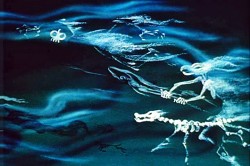 5
5 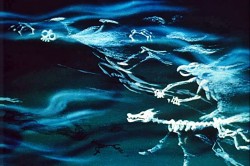 6
6
However on the second shoot, they started by shooting a black frame.
This made #1 fall where #2 should have been, #2 for #3 etc.
This creates a ghostly dissolve effect.
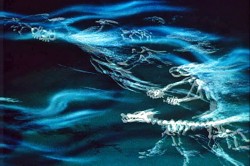 6a
6a 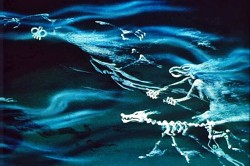 7
7
All of the drawings labelled with an “a” are the double exposures:
2a, 4a, 6a
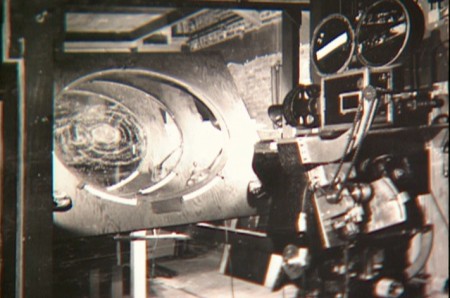
A make-shift circular multiplane camera was built.
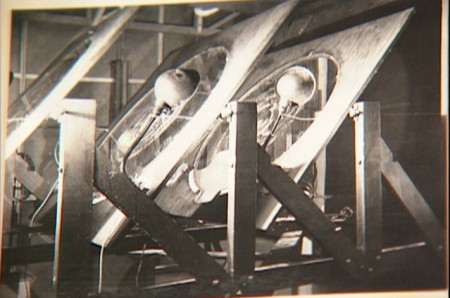
Created out of wooden sheets with holes cut out,
placed so they could shift angles, they were designed to
allow revolving artwork in the circular cut outs.

This allowed shooting scenes such as this shot of
a spider web as the camera moved around it
while dew glistened off of it.
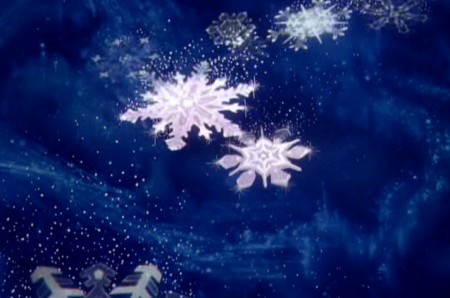
The spinning snowflakes are well explained in Schultheis’ book.
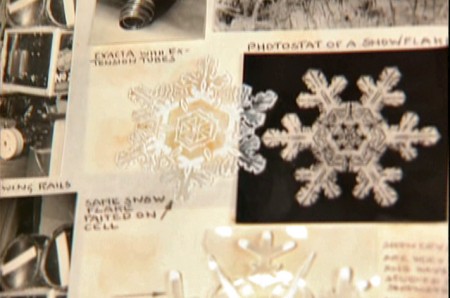
The snowflakes had a detailed construction.
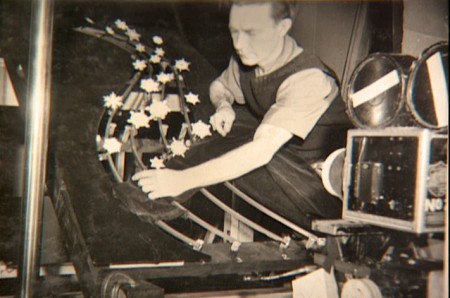
The path of action was intricately defined.
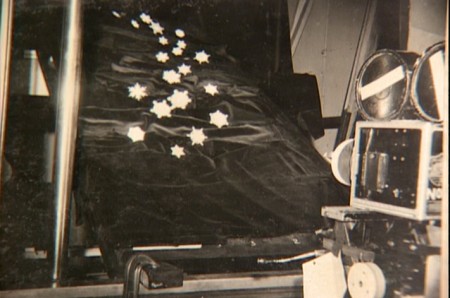
The snowflakes were shot against a sheet of
black velvet hiding the wire guides.
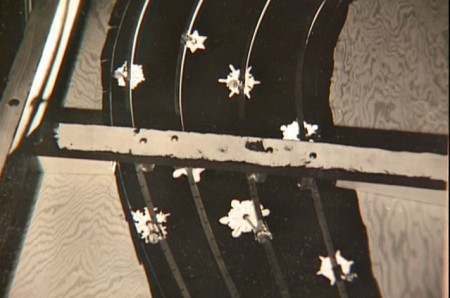
They were shot in tight closeup. From below you can
see the turning gears they were constructed on.
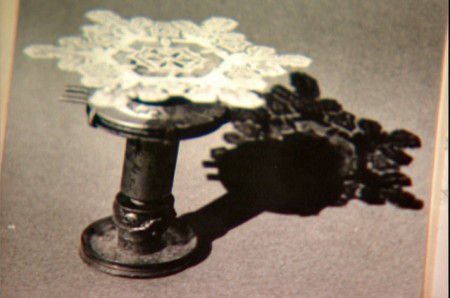
Each snowflake was built on a turning gear
so that they could revolve in their path of action.
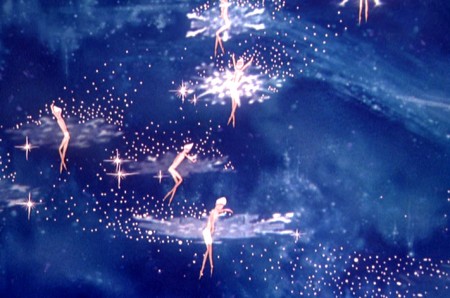
Burn these snowflakes over the multiplane background
and add matching 2D animated fairies within each snowflake,
and you have the finished scene.
Animation &Commentary &Hubley &Independent Animation &Layout & Design &repeated posts 25 Jun 2012 06:29 am
Everybody Rides – repost
I posted this in the summer of 2008. I’ve ganged two parts together to make one read.
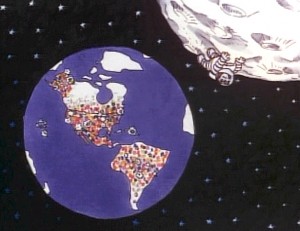 - Back in 1976, I was working on John Hubley‘s Bicentennial flm, PEOPLE PEOPLE PEOPLE. This was a short film, four minutes long, that had about a million scenes. It told the history of the US (from the standpoint of populating and overpopulating) beginning 17760 BC and ending in 1976 AD.
- Back in 1976, I was working on John Hubley‘s Bicentennial flm, PEOPLE PEOPLE PEOPLE. This was a short film, four minutes long, that had about a million scenes. It told the history of the US (from the standpoint of populating and overpopulating) beginning 17760 BC and ending in 1976 AD.
It started with some lengthy scenes. As the film moved on, the cuts came faster, until they hit about 6 frames apiece toward the film’s end. The final scene, from space, was the longest in the film.
There were no characters that appeared in any more than one scene. That meant that with each scene, there were new setups, new characters, new colors, new everything. As a result, it took much longer than other films and was a difficult one to pull off. But like all other Hubley efforts, it was fun. Tissa David, Jack Schnerk, Lu Guarnier, Phil Duncan and Bill Littlejohn animated it. I colored about 2/3 of the film and animated at least a dozen or two scenes (some really were only 6 frames – like that auto shot posted). I also assisted/inbetweened all of the animators.
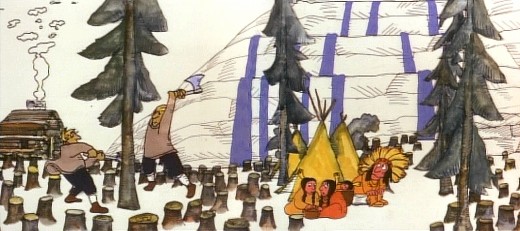
Swedes cut down all the trees in PEOPLE PEOPLE PEOPLE.
The studio, at the time, was buzzing because John and Faith had just sold a dream project to CBS. EVERYBODY RIDES THE CCAROUSEL was an adaptation of Erik Erikson‘ 1956 book, Eight Stages of Development. Erikson was a psychologist who theorized that man goes through eight stages of development from birth to death, and he proceeds to break them down. The Hubleys took this book and broke these eight stages into horses on a carousel.
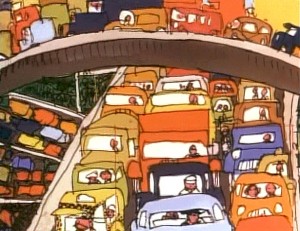 The three half hour Special shows for CBS would be about these carousel horses and the ride.
The three half hour Special shows for CBS would be about these carousel horses and the ride.
Each of the stages would be broken into two different subsets, and these would be depicted through stories which were roughly developed visually by John and Faith. Once the funding started to tricle in (about $450,000 for all three shows) they would cast their many actors and have them improvise in the recording studios to the storyboarded set pieces.
While those recordings progressed, the small studio staff was busied in completing animation, artwork and rendering of PEOPLE PEOPLE PEOPLE.
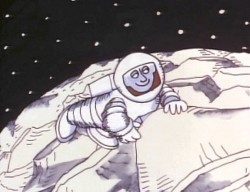
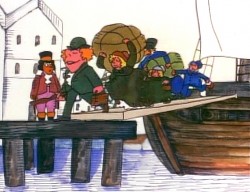
The man on the moon and the Irish immigrants.
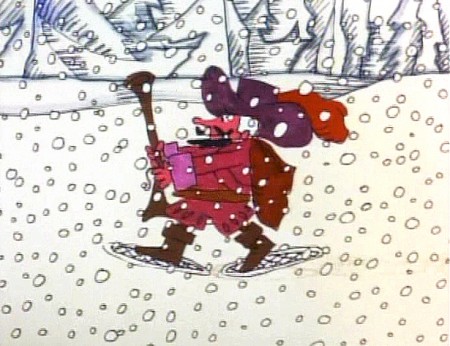
Jack Schnerk animated the French trapper sequence. There was such a rush
on the scene that I remember Jack bringing it in saying he hoped it would work.
He’d done two drawings of snow for the blizzard. Both wildly different from each other.
He asked me to ink them, then flop the drawings and ink them again.
He’d exposed the four drawings on fours. He also had the trapper with
snowshoes walking on fours. He felt it would help us feel a struggle in his
walking through the snowstorm. He felt the fours might add weight.
The scene worked beautifully, and was excellent the first time out.
Not quite the way they’d have done it at Disney. Tricks of the trade.
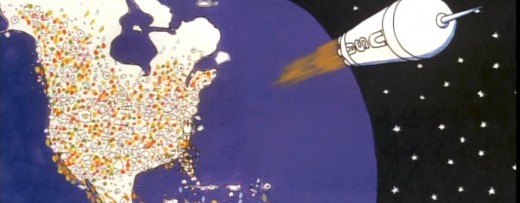
Tissa animated a majority of the film. The ending, the man going to the moon to escape
the overpopulated earth was hers. I have the drawings somewhere and will post some of them soon.
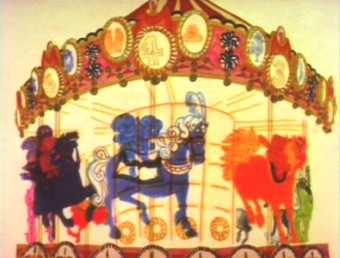 – We started slowly on Everybody Rides the Carousel. There was a six month schedule for about 72 mins of animation. Three half-hour original tv shows for CBS about 24 mins each. They’d air in the late summer of 1975 just prior to the start of the new tv season. Each show would air a day apart from the others – three nights in a row.
– We started slowly on Everybody Rides the Carousel. There was a six month schedule for about 72 mins of animation. Three half-hour original tv shows for CBS about 24 mins each. They’d air in the late summer of 1975 just prior to the start of the new tv season. Each show would air a day apart from the others – three nights in a row.
John and Faith spent a lot of time – a lot of time – at RCA studios on 45th Street. (It’s
____ The carousel was bottom lit & became soft focus.____-_ now an IRS office.) They recorded many of the voices playing the numerous parts in their show. I tried to time meeting them there a couple of times hoping to meet some of the actors (I particularly wanted to see Jack Gilford in action. He was doing an hilarious part with his wife, playing a couple of cranky old people in a diner.) It didn’t work out that way, but I did see the facility and heard parts in process.
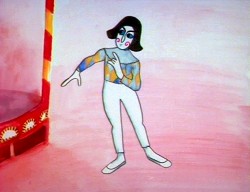 The key staff working IN the studio (not counting animators who would, for the most part, work freelance) included Ida Greenberg. Ida was a brilliant checker / coordinator who’d started back in the Florida days of the Fleischer studio. (She told me a few great stories about Gulliver’s Travels.) Ida was a great woman, with the thickest New Yowk accent, who never seemed to buckle under pressure. I grew very close to her. I tried after that to have Ida everywhere I worked. She led Raggedy Ann’s I&Pt and R.O.Blechman’s special.
The key staff working IN the studio (not counting animators who would, for the most part, work freelance) included Ida Greenberg. Ida was a brilliant checker / coordinator who’d started back in the Florida days of the Fleischer studio. (She told me a few great stories about Gulliver’s Travels.) Ida was a great woman, with the thickest New Yowk accent, who never seemed to buckle under pressure. I grew very close to her. I tried after that to have Ida everywhere I worked. She led Raggedy Ann’s I&Pt and R.O.Blechman’s special.
Kate Wodell was a student of the Hubleys at Yale. She was a talented artist who’d moved into production during the making of Cockaboody and continued on staff there. Sometimes she colored, sometimes she animated, sometimes she did whatever was necessary. This was exactly how I moved into the studio and loved the experience. She worked with Faith for many years after John died.
Earl James was an animator who’d worked in the backroom of many NY studios from Paramount to Terrytoons to NY Institute of Technology. He also had done some comic strip work.
Earl was given the carousel to animate. This came from a couple of elaborate drawings John did. Earl worked 16 fld. using a 96 drawing cycle. It gave us a lot of opportunity to move in tight or stay wide. However, it was a nightmare that took forever. Joe Gray was hired to assist Earl. (Joe started during the Terrytoons strike and never left. Many of those who knew him as a “scab” never forgave him and had only horrid things to say about him to me some thirty years later. He was a lifetime assistant like a handful of other noted names in NY.)
This scene moved so slowly through production that I kept jumping in to assist as well. I was a fast assistant, but that carousel slowed even me down. 8 horses moved in perspective in a circle; there were 96 different rotating views of all the horses. I’d guess the scene took about 10 weeks to complete.
I was also doing layout and animation of a lot of connecting scenes throughout the production. These were scenes that would have to blend from one animator to another, or John had decided to go in tight for a closeup. In one case with Art Babbitt’s mime character, I was asked to change it from two’s to four’s with a dissolve technique John taught me (he said they’d used it on Fantasia.)
There were four people in my room, Earl, Joe, me and Mark Hubley. He worked alongside me for most of the film. He colored artwork given him by Ida, who was working in the larger room next door. Mark and I had a good releationship going back the many years I worked there. He joined the studio once he completed college. Emily Hubley worked alongside Kate and Ida.
Two younger, more experimental animators were brought in by John. Adam Beckett had made a name for himself with the films he was doing at CalArts.
Fred Burns was doing some incredible work at UCLA. They both were very different and added their unique touch.
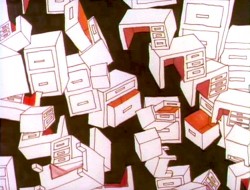
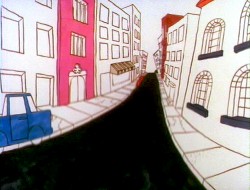
___________ Adam Beckett’s scenes included these two surreal images.
Adam did a scene a couple of scenes wherein office furniture floated about in a very complicated surreal cycle. Fred did this amazing scene of a roller coaster from the POV of the rider. He and I worked together a number of times after that, and we’ve stayed friends.
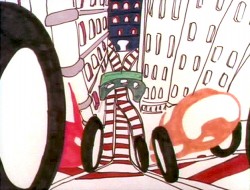
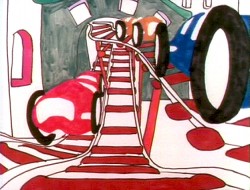
______________ Fred did this very elaborate sexual roller coaster.
I hope to have more to say about some of these films I worked on.
Books &Disney &Illustration 31 May 2012 06:14 am
Retta Scott’s Cinderella
– Retta Scott‘s name was always an intriguing one for me.
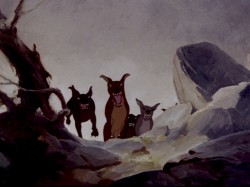 She was an animator on Bambi, Dumbo and Plague Dogs. She was layed off at Disney’s when they hit a slump in 1941 but came back to do a number of Golden Books for Disney. The most famous of her books was her version of Cinderella, one which was so successful that it remains in print today as a Little Golden Book.
She was an animator on Bambi, Dumbo and Plague Dogs. She was layed off at Disney’s when they hit a slump in 1941 but came back to do a number of Golden Books for Disney. The most famous of her books was her version of Cinderella, one which was so successful that it remains in print today as a Little Golden Book.
When asked why females weren’t animators at the studio, the Nine Old Men who traveled the circuit, back in the 1970′s, often mentioned her. They usually also said that she was one of the most forceful artists at the studio, but her timing always needed some help (meaning from a man.)
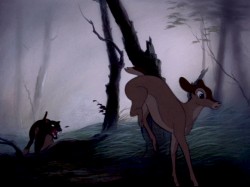 Ms. Scott was known predominantly for her animation in Bambi. Specifically, she’s credited with the sequence where the hunter’s dogs chase Faline to the cliff wall, and Bambi is forced to fight them off.
Ms. Scott was known predominantly for her animation in Bambi. Specifically, she’s credited with the sequence where the hunter’s dogs chase Faline to the cliff wall, and Bambi is forced to fight them off.
The scene is beautifully staged and, indeed, is forceful in its violent, yet smooth, movement. I was a young student of animation, at the time, so this sequence has always had a long and lasting impression on me.
.
,
I’m curious to know how Western Publishing proceeded with the illustrated Disney books. Apparently a large number of Disney artists contributed to the books – at least in the 40′s & 50′s. Bill Justice, Dick Kelsey, Mary Blair, et al. Then, of course, there are the Golden Books that didn’t have a Disney connection by Disney artists. The Poky Little Puppy by Gustaf Tenggren is, of course, the most famous of these.
(Retta Scott working on Pastoral seq. from Fantasia. From The Art of Walt Disney by Finch.)
Here are some of her illustrations for Cinderella published in 1950 to tie in with the Disney film. Oddly, the illustrations don’t completely look like the film’s characters. The cat and mice are close, but Cinderella, herself, is very different, less realistic. She looks more like a Mary Blair creation. When I was young, I was convinced that these were preproduction illustrations done for the film. If only.
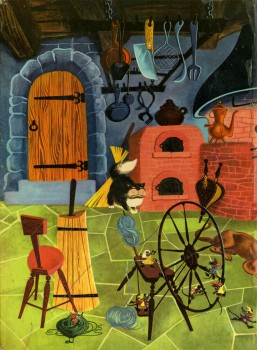
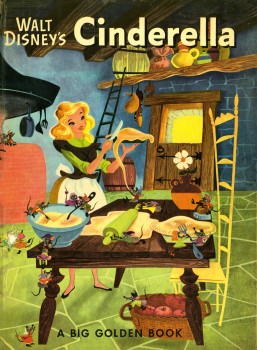
Commentary 08 Apr 2012 07:02 am
Moving On
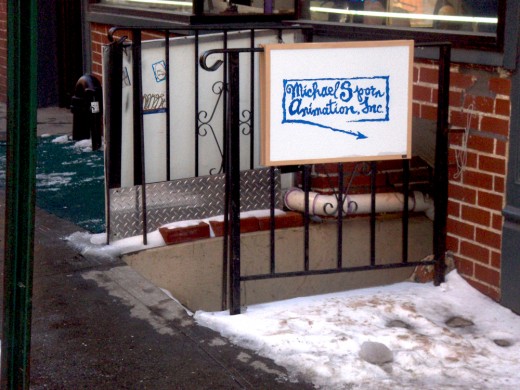 - It’s a week later, and the move out of the Bedford Street studio is done. Most of the furniture, artwork and computers have been put in storage. It was a big decision to have made and done quickly and expeditiously. It was also a touch traumatic. Giving up the space wasn’t easy. I’d been thinking of doing it for the past year, and the inevitable had to happen. I realized that only a couple of weeks ago.
- It’s a week later, and the move out of the Bedford Street studio is done. Most of the furniture, artwork and computers have been put in storage. It was a big decision to have made and done quickly and expeditiously. It was also a touch traumatic. Giving up the space wasn’t easy. I’d been thinking of doing it for the past year, and the inevitable had to happen. I realized that only a couple of weeks ago.
So now I’m working out of my home and will also be occupying a desk alongside Candy Kugel at her company Buzzco; she’s given me access to her facilities. That will get me out of my house and make my days a bit more interesting. Lest there be any doubt, Michael Sporn Animation, Inc. still exists, and in fact we’re currently working on a spot for AARP with Bob Blechman. That’ll be done in the next week. Matt Clinton is doing his part out of Michigan, while I work in the City.
A couple of big thank you’s for the move have to go out to two great friends. The move could not have happened without the back breaking work of Stephen MacQuignon. What a guy he is; I just can’t say enough about him. Bridget Thorne was also essential in getting it going and boxing up so many damn books. She was the vision behind the move. Of course, Heidi Stallings, my wife, was there all the way with me making sure I didn’t push too hard. Thank you to all three of them.
- I’m haven’t surrendered to Kickstarter after not reaching the enormously high goal I’d set for myself. I’m hoping to start anew in the next week or so, but this time I’ll be using Indiegogo. It seems much more reasonable in the way they’re set up. Of course, I’ll reach out and let you know when I’ve got it going. I want to get started on POE‘s opening and have been working by myself, for now, on that. Any moneys I can generate through such a device would be glorious.
- Gene Deitch on his site, gene deitch credits, has an absolutely great piece about Morton Schindel. Schindel was the smart entrepreneur who set up Weston Woods in the 1950s, and he deserves more attention in the business. His company has thrived for more than fifty years doing quiet films based on well-known children’s books. Deitch got a firm foothold of a customer with Weston Woods, and I got my real start as a studio with a couple of films from the Schindel, and the guy who actually runs the production now, Paul Gagne.
I knew that the early WW films were shown on Captain Kangaroo, but I wasn’t aware that Gene Deitch was responsible for that happening. It’s a good little piece of history worth reading.
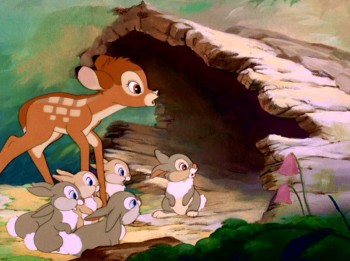 -With the recent introduction of their new cable channel, Disney Junior, Disney has been screening a number of the early animated features on the channel. I happened to catch Bambi yesterday. Of course, it’d have been easy for me to just put in the DVD, but somehow accidentally coming upon the film makes it hard to pass up. Considering how immersed I’ve been in the UPA films and the Miyazaki canon, it always brings you back to ground zero when you see one of these early Disney masterpieces. They can’t be beat. Bambi, in particular challenges any notions of modern art with Tyrus Wong‘s stunning Backgrounds and design. The Bgs turn almost abstract at times. When the deer on the meadow are running away, for fear of man, the animals turn wildly brilliant colors. It caught my eye the first time I saw the film, as a child, and I still look for it.
-With the recent introduction of their new cable channel, Disney Junior, Disney has been screening a number of the early animated features on the channel. I happened to catch Bambi yesterday. Of course, it’d have been easy for me to just put in the DVD, but somehow accidentally coming upon the film makes it hard to pass up. Considering how immersed I’ve been in the UPA films and the Miyazaki canon, it always brings you back to ground zero when you see one of these early Disney masterpieces. They can’t be beat. Bambi, in particular challenges any notions of modern art with Tyrus Wong‘s stunning Backgrounds and design. The Bgs turn almost abstract at times. When the deer on the meadow are running away, for fear of man, the animals turn wildly brilliant colors. It caught my eye the first time I saw the film, as a child, and I still look for it.
The beauty of some of the animation cannot be challenged, and the airbrushed coloring is stunning. Looking at some of the simple and direct multiplane setups one can only sit in awe. There’s a bit of randomness that has to take over with the multiplane camera, and that brings a touch of life to these camera moves. A good example is the very last scene of the “April Showers” sequence with the camera making a very slight move down and a pull out to reveal Bambi and his mother in the larger forest. The out of focus elements shift to in-focus, and it’s beatuiful. Even watching this film with the advanced use of the computer to composite such films today, the production work can’t be beaten or matched.
We’ll never see the likes of the pre-1942 films again. Snow White, Pinocchio, Bambi, Fantasia and even Dumbo are in a class of their own and will never be matched again. And here they are running on Disney Junior, the toddler’s channel. It’s always good to go back to these films to get a good sense of animation-history reality.
Animation &Animation Artifacts &Disney 29 Mar 2012 06:49 am
Mickey Turns in Water
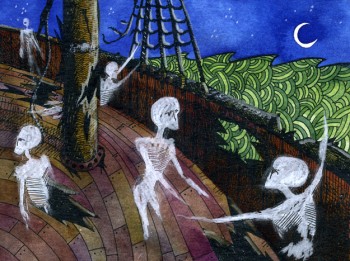
- Before we get into today’s posts, I have to remind you again
that today’s the last days of our
Anything you can offer to the POE Project would be appreciated.
Thanks for your support.
________________________
- Here’s another Preston Blair scene of Mickey, half under water, turning with some surprise. Of course, the scene is part of The Sorcerer’s Apprentice from Fantasia.
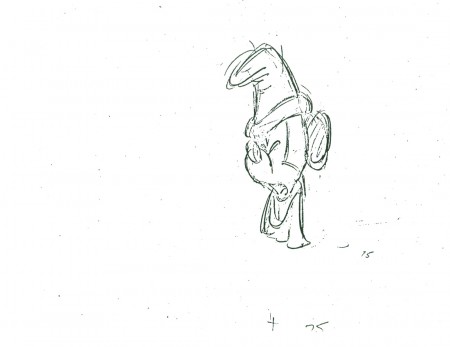 75
75
______________________
The following QT includes all the drawings posted above.
The registration is a bit loose. Sorry but, these are obviously
copies of copies and there’s plenty of shrinkage and distortion.
Animation &Animation Artifacts &Disney 29 Feb 2012 07:33 am
Mickey Flutters Fingers
- It’s animation drawing Wednesday, and I have a few more scenes by Milt Kahl of Roger from 101 Dalmatians. However, I want to take a short break from those scenes which are large and difficult to scan in.
I have a number of scenes of Mickey from The Sorcerer’s Apprentice. They all came with nothing. No exposure sheets, no registration marks or pegs, no anything, So, basically, I’m just showing off some drawings, trying to register them as best I can and then giving a guess of an exposure to hint at their motion. But I think there’s something to be gained, or I wouldn’t be doing it.
Since there’s no indication of a repeated step from Mickey, and knowing it’s in the scene, I doubled it in the QT movie to see how it works. It’s all fun and variations for me here.
This is Seq 7 Scene 4 animated by Les Clark. Mickey is instructing the newly livened broom to march step and follow him.
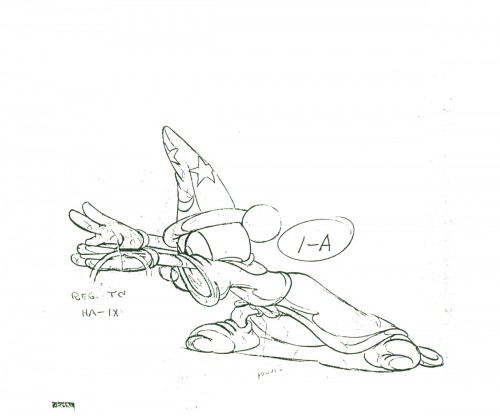 1A
1A
______________________
The following QT includes all the drawings posted above.
The registration is a bit loose. Sorry but, these are obviously
copies of copies and there’s plenty of shrinkage and distortion.
Animation &Animation Artifacts &Disney 04 Jan 2012 07:20 am
Broom X Sheets
- This post is for real animator-type geeks. To complete the posting of the scene from Fantasia of Mickey chopping the broom, I have the exposure sheets as well as some notes and that I’d like to share. If you know how to read the sheets, it’ll be informative. If you don’t, take some time to try to understand them. Although there are some complications – several dissolves and indicated effx, specifically – much of it is basic.
These are all copies of copies, so the quality isn’t the greatest.
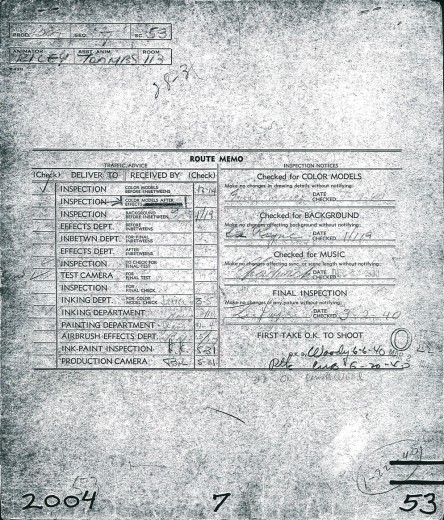
This is the cover of the folder for the scene.
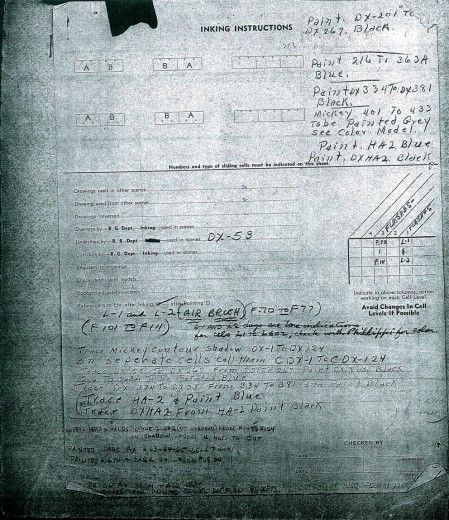
Inking instructions within the folder.
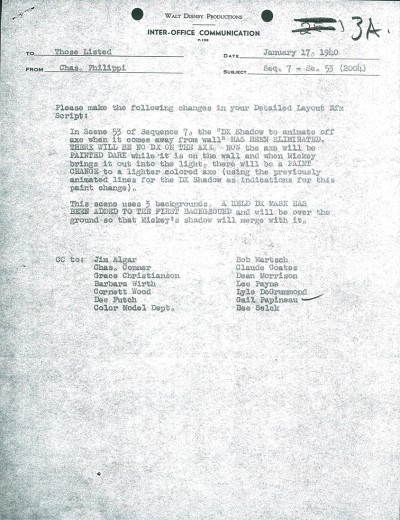
An interoffice communication about the scene.
The following are four samples of effx shading that was done
for all of Mickey and the brooms throughout the scene.
I show the original drawings followed by the effx drawing.
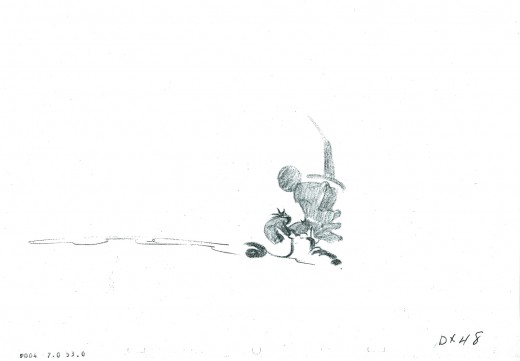
All of the effx drawings were done with a very light hand.
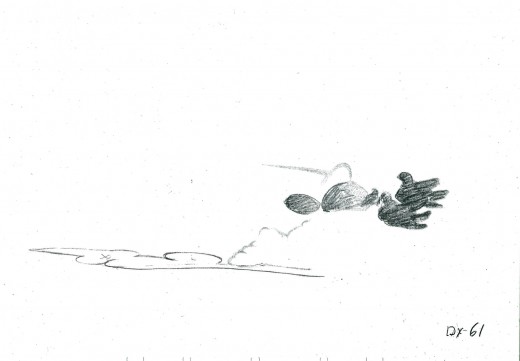
I had to push them like crazy in Photoshop so that you could see them here.
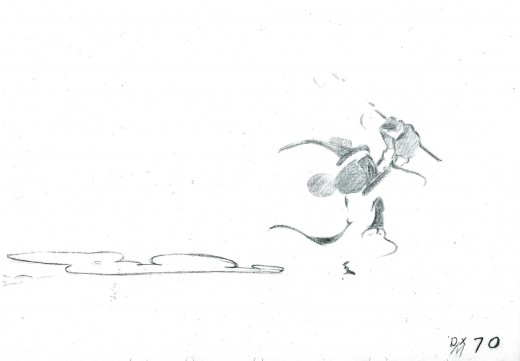
All of the Mickey & broom drawings were done this way as an
indication to the airbrush artists who would follow up.
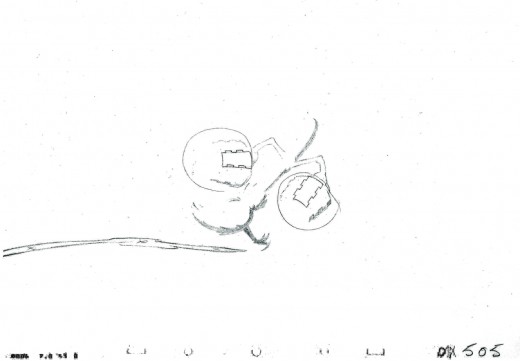
You’ll note that the scene was about to be reshot for the airbrushing.
The Exposure Sheets
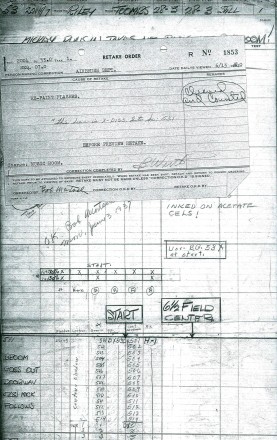
Here is a note attached to the first page of the
exposure sheets about a reshoot.
